Educating Injury Victims
- Slip and Fall
- How to File a Claim
- Writing a Report
- Sample Incident Report

Sample Slip and Fall Incident Report Form
Make sure there’s a written report for slip and falls away from home. use this form if the property manager didn’t make an incident report..
If you suffer a slip and fall injury on someone else’s property, you have the right to seek compensation. Usually, that means filing a claim with the property owner’s liability insurance carrier. However, you won’t get far with an injury claim unless you can establish when and where you got hurt.
Never leave the scene of a slip and fall without reporting the incident . Most stores and other businesses will have an incident report form to be filled out by you or the store management. You can ask for a copy of the completed form, but most businesses won’t give you a copy just by asking. It’s enough to know that a written report of your fall is on record.
If the property owner or manager says they don’t fill out an incident report form for accidents like yours, get the name of the employee you notified, then use this free resource to create your own written incident report.
Click on the image below to download the PDF report form:
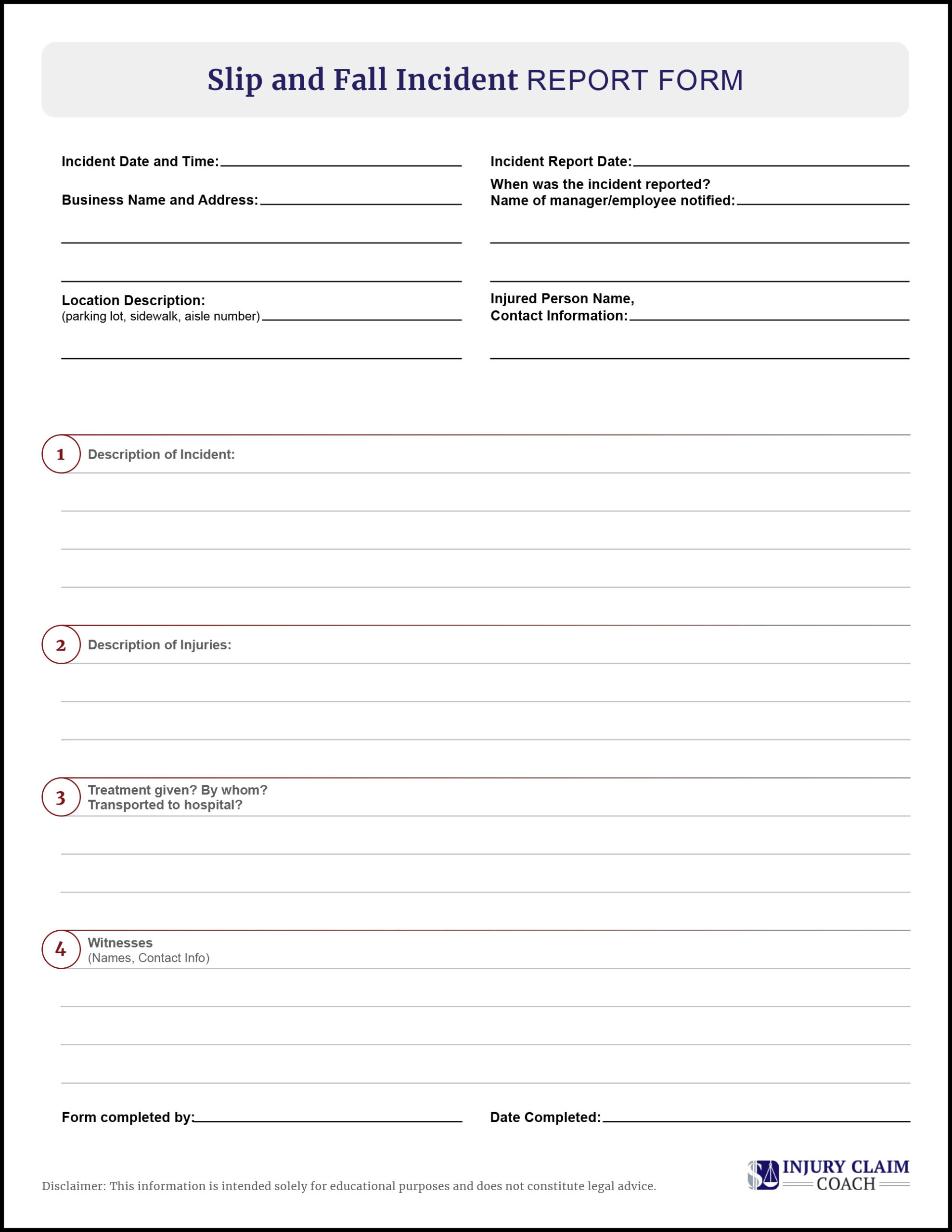
Documenting Your Slip and Fall Is Vital
What happens after a slip and fall accident can make or break your claim. The worst thing you can do after a slip and fall is to pick yourself up and leave in embarrassment. You may have sustained significant injuries that won’t be apparent for several hours. After the shock and adrenaline from a violent fall wears off, your pain and other symptoms will show.
You must connect your slip and fall injuries to the date, time, and location of the accident.
After a fall, ask an employee or a bystander to get the manager. Tell the manager you want an incident report made of your fall. Give them your name and contact information. If they say they don’t use an incident report form, get the name of the employees or manager you spoke to at the scene.
If your injuries are immediately obvious, your first priority is to get emergency medical attention. Never refuse medical attention at the scene. If an ambulance has been called, let the paramedics look you over. Cooperate if they want to take you to the hospital. The ambulance report will document the place and date of your injuries.
Waiting to report your injury can seriously undermine your chances of getting fair compensation, as will a delay in medical treatment. Any insurance company will use a delay as an excuse to deny your injury claim. The adjuster will argue that your injuries did not happen on their insured’s property.
How to Use This Slip and Fall Incident Report Form
If you aren’t sure that the property owner filed an incident report after your slip and fall accident, fill out this handy incident report form as soon as possible after the accident.
The top of the report form is for the date and time of your slip and fall, the business name and address, where you fell (like a parking lot, produce section, etc.), and the names of the store employees you talked to. You’ll also fill in your contact information and the date you are preparing the incident report.
Provide as much information as you can in the sections provided. Be factual. Don’t offer opinions or criticism.
Describe the incident in detail, including where you were on the property and how you fell. Be specific if there was a wet floor , debris in the walkway, ice or snow , or any other hazardous condition that led to your fall.
Be sure to point out that there were no wet floor signs or other warnings of the danger, and there was nothing you could have done to prevent your fall.
You won’t know the extent of your injuries, but you can describe the pain you experienced, any numbness, swelling, or bruising that’s immediately apparent. Also describe if you were unable to move a body part, or unable to walk properly, or unable to stand without help.
The incident report should include any treatments you got at the scene (including first aid from an employee) or immediately afterward.
Include the name and contact information for any witnesses to your slip and fall , even if the witness was a friend or family member.
Sign and date your incident report form. Make a copy of the first page to mail to the property owner. Keep the original to put in your injury claim file .
Helpful Tips After a Slip and Fall
Never make excuses or apologize for a slip and fall. You may be embarrassed, but this is not the time to make jokes about being clumsy or say, “ Only my pride was injured. ”
If you aren’t taken directly to the hospital after a slip and fall, you must seek medical attention as soon as possible, preferably the same day. You can see your primary health care provider, visit an urgent care center, or go to the hospital emergency room.
Be sure to tell every medical provider exactly when, where, and how you were injured.
Write down everything you can remember while the circumstances surrounding the slip and fall are fresh in your mind. No detail is too small for your injury diary. For example, if someone who works where you fell apologized or made excuses for the hazard that caused your fall, that information can help your injury claim.
Whether you decide to handle your own slip and fall claim or hire a personal injury attorney, an incident report and timely medical attention can help you get the injury compensation you deserve.
How Much is Your Injury Claim Worth?
Find out now with a FREE case review from an attorney…
- Your Accident
- Contact Info
- Your Evaluation
So far so good! Please answer a few more questions and then click "Go to Last Step"
Unfortunately, based on your answers we can’t provide a case review. But you may qualify for pre-settlement funding.
This funding gives you the money you need to cover personal expenses now. Approval takes < 24 hours with no credit checks and no obligation — you only pay it back if you win your claim. Funding can range from $500-$100,000, depending on your case and needs.
We respect your privacy. The only person who may contact you is a licensed attorney who can help.
By submitting, you agree to the Terms & Conditions. You consent that the law firm you are matched with or a call center may contact you by phone and/or text, even if you are on a Do Not Call Registry. You agree these messages may be auto-dialed or pre-recorded, and consent is not a condition of purchase.
Unfortunately, based on your answers, we will not be able to help you. But that does not mean you do not qualify.
Please use the button below to see how else we can help.
View More Options for Help with your Injury
- Attorney Info
Please answer a few more questions and then click "Go to Last Step"
By submitting, you agree to the Terms & Conditions. You consent that the funding company you are matched with or a call center may contact you by phone and/or text, even if you are on a Do Not Call Registry. You agree these messages may be auto-dialed or pre-recorded, and consent is not a condition of purchase.
Success. You will be contacted soon about your funding.
If you’ve been injured in an accident, you may qualify for a settlement. Click here to see if you qualify now .
Find out now with a FREE case review from an attorney…
1 st Reporting
Slip, Trip, and Fall Incident Report (2023 Edition)
Slips or trip and fall reports are a necessary part of incident management. Slips and falls account for the most considerable portion of workplace injuries that result in lost time accidents. Due to the potential severity of such seemingly trivial events, instituting a proper trip and fall report into your organization becomes essential.
Organizations use a slip, trip, and fall report in the workplace to record observations of a slip, trip, and fall incident. As this type of incident is the most common, it becomes clear that a dedicated form for standardized reporting is obviously needed across industries and organizations.
This guide will outline what needs to be on a slip, trip, and fall report, why they are so critical, how to use the report, and further best practices for your team. Furthermore, we have a downloadable PDF or a digital version of our form on the 1st Reporting app for you. Stick with us until the end, and you’ll learn some valuable tips and insights into how you can reduce the risk of these common injuries and create a safer workplace (while simultaneously making your job easier). Let’s get started.
Table of Contents
Included in the Slip, Trip, and Fall Report Template

You’ll notice that our Slip, Trip, and Fall Report Template includes six conveniently separated regions. I recommend you bookmark this page to reference it later to help you train your team on the report’s intended use. Let’s talk briefly about what we’ve included in the separated regions of our Slip, Trip, and Fall Report Template.
Administrative Data
At the top of the ST&F Report (Slip, Trip, and Fall Report), you’ll notice that there is a convenient section to include data such as the name and contact of the injured party, the location, date, and time of the incident, the date and time of the report creation and when the incident was initially reported. Further details are also included to ensure ease of information sharing. Furthermore, this information is critical to properly sort, file, store, and retrieve your paper reports.
Description of Incident
For obvious reasons, a detailed description of the incident is needed on the form. We’ve provided ample space for your report creator to include the information. Remember to provide this information clearly and concisely, without judgment or malice. The key here is impartiality. You want to record the events as they unfolded and refrain from including personal judgments or assumptions. Remember, the intent here is to document observations objectively and without bias.
Description of Injuries
Following the incident description, which is vital for your Root Cause Analysis, we’ve included an area to document the extent of the injured party’s injuries. Again, it’s critical to reserve judgment and only record observations truthfully and without bias.
Treatment Provided
Treatments as simple as washing a cut and putting on a bandage are still treatments provided. Ensure that in the case of a slip, trip, and fall event, you record and document the event in its entirety. To properly analyze and work toward incident prevention, all information relevant to the scenario must be found in your report. Documenting treatment is also required in terms of liability. Whether it’s one of your team administering emergency first aid or even calling 911, either way is an action to provide or have a professional provide treatment.
Witness Information
When an accident happens, you must record any witnesses present and privy to the incident. Anyone who saw what happened should have their name and contact information on the slip, trip, and fall report. This contact information may be vital later, so don’t skip noting witness information.
Finally, the bottom of our slip, trip, and fall report contains a section for your report writer to sign off on the report’s authenticity and provide a completion date. Adding these pieces of information provides two critical things. First, a signature pushes team members to complete their reports honestly and as directed or requested. Secondly, it provides a means of knowing when the report was completed.
How to Use a Trip and Fall Report Form

Using our trip and fall report is straightforward. You only need to download our form and print as many copies as you see fit. Remember that the annual percentage of workers who will face a slip and fall incident is typically around 2.5-3%. For every 100 team members, you can anticipate 3 of them having a lost time accident due to a fall every calendar year. Remember that these are average numbers based on historical data, and the better you prepare and prevent, the lower your chances of having an at-work incident.
Tips For Managing Slips or Trip and Fall Reporting

Slips, trips, and falls are nothing new in the workplace. No matter the country or industry, we all face daily risks at work. Seton.co.uk says 29% of all workplace accidents reported are slips, trips, or falls. That’s a third of all reported injuries at work in the UK. That’s a significant number, and it’s no different in North American countries.
Luckily, we’ve got much experience in reporting injuries. You might say we are experts in workplace reporting and documentation. That said, we’ve compiled a list of the best things you can do to make a difference in your organization.
Standardize Procedures
Encourage hazard recognition and jobsite awareness, implement strict engineering and administrative controls, don’t forsake training, implement digital report solutions.
To make the most of these tips, let’s dig a little deeper into each to find out the best way to implement them into your operations.
I can’t stress enough how essential it is to define procedures for injury incidents. These types of incidents are critical to handle appropriately and not just to come to the aid of the injured party. Given the nature of injuries at work, it’s easy to understand how team members might be too stressed or flustered to deal with an injury incident appropriately.
Due to the importance of handling injuries properly, we’ve created the Injury Procedure Checklist – a tool you and your team can use to ensure that all team members follow the proper steps in dealing with an injury incident at work.
I’ve worked at plenty of companies where bad cultural practices discourage safety. You know, the types, those managers who tease or taunt team members over safety concerns. These sorts of occasions call for more level-headed approaches to management.
The best thing you can do, whether a manager or a worker, is to encourage safety, safety awareness, and hazard recognition. Here’s how:
- Thank coworkers for their input.
- Discourage anyone from behaving in a way that makes people feel pessimistic about addressing safety concerns.
- Listen and act: When a team member shares a safety concern, listen to them and act accordingly to help prevent or mitigate threats and hazards.
Implementation of strict engineering controls and administrative controls to prevent and stop injury incidents is critical to a successful health and safety policy. Ensure that your maintenance team is capable of dealing with safety concerns promptly. Maintaining an intelligent work order document control system will help to ensure that safety concerns don’t retain their hazard for longer than necessary.
Training is vital to a safe work environment. Management often thinks of training negatively because it is a cost of business without an apparent return on investment. However, the cost of loss of life and limb is always higher than the cost of training.
The biggest mistake I’ve seen in companies over the years is their neglect of refresher safety training. Furthermore, I’ve witnessed far too many lazy managers joke about the lack of importance of safety training. Remember that problems in companies usually start at the top and trickle down. So, if you want a safe work environment, you need to work to maintain it actively.
Implementing a digital reporting system was one of the smartest moves I have ever made in operations management. I can’t tell you how many times paperwork came back incomplete, messy, or didn’t come back at all. Digital reporting changes all of that in an instant.
Take the 1st Reporting app, for example. It’s easy to install on any Android or iOS device, works with your desktop or laptop, and even works with the Microsoft Teams® environment. Furthermore, the customizable template builder makes the app reporting custom to your operations (very convenient).
Despite the money saved from not printing paper reports (ink gets expensive, fast), the greatest savings are from the efficient and effective means of reporting and documenting incidents, inspections, audits, and even things like daily shift reports or other reports.
1st Reporting delivers an all-inclusive reporting management experience, from mobile form completion in the field to form customization for your entire organization. It’s my go-to for GPS-accurate reporting solutions. It works on the fly, in the field, and even when out of a cellular signal.
Please don’t take my word for it; take your competitors’ word (they are probably already using 1st). The only question remains: Why haven’t you implemented digital reporting in your organization yet?

Join the globally-recognized brands that trust 1st Reporting to safeguard their organizations!
Privacy Overview
Customize your template.
Work with our team of experts to customize our templates to your exact business needs.
- First Name *
- Last Name *
- Phone Number * ✓ Valid number ✕ Invalid number
- Changes Requested
- By submitting your information you agree to receive email marketing and promotional communications from 1st Incident Reporting
- Phone This field is for validation purposes and should be left unchanged.
Free Template Download
- I would like to learn more about a digital solution to manage my reports
- Comments This field is for validation purposes and should be left unchanged.

Real Examples of Incident Reports at the Workplace with Templates
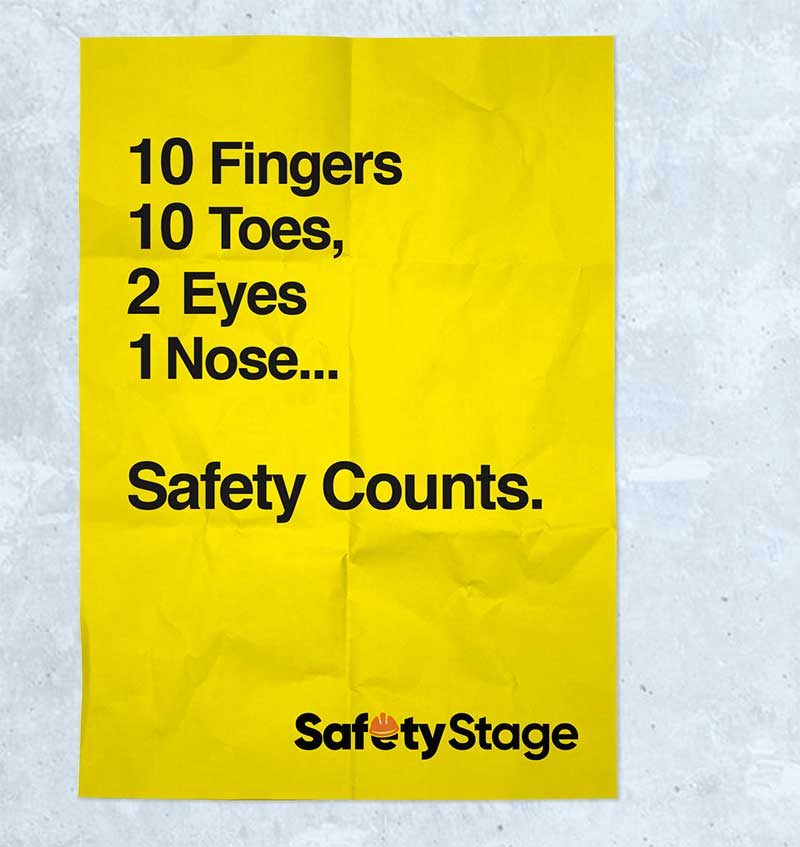
Accidents can happen, no matter how many preventative measures are in place. And, when accidents do happen, it’s vital to learn from them. To ensure your documentation is spotless, it’s always a good idea to look at some example incident reports at the workplace.
A safety incident report helps ensure nobody is subject to mistreatment because it contains information from the injured employee as well as eyewitnesses. This helps fill in missing pieces of information and figure out how the accident occurred exactly.
“The safety of the people shall be the highest law.” Marcus Tullius Cicero
So, let’s dive in!
If you’re looking for an example of an incident report at the workplace, feel free to jump to that section using the links below. Otherwise, we will first discuss what incident reports are and why they are so important.
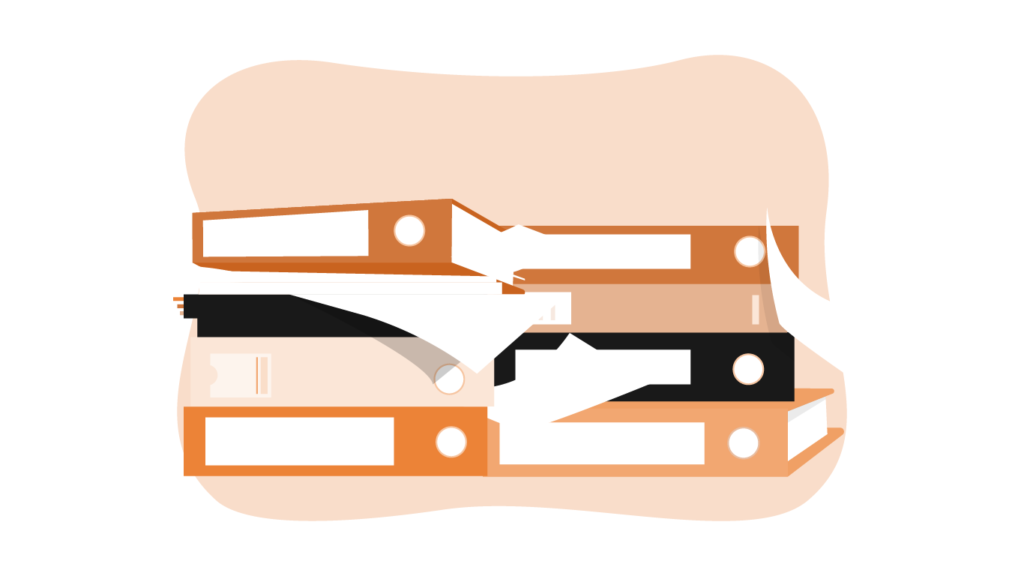
What is a Workplace Incident Report?
A workplace incident report is a document that states all the information about any accidents, injuries, near misses, property damage or health and safety issues that happen in the workplace.
They are very important to identify the root cause of an incident along with any related hazards and to prevent it happening again in the future. As soon as an incident takes place and everybody in the workplace is safe, a work incident report should be written up.
Typically, a workplace accident report should be completed within 48 hours of the incident taking place . The layout of an accident incident report should be told like a story, in chronological order, with as many facts as the witnesses can possibly remember.
What should you include in an incident report?
There are many different types of incident reports, depending on your industry, but most will include the underlying details listed below in order to understand what happened:
- The type of incident that took place
- Where the incident happened
- The date, day and time of the incident
- Names of the people involved
- Injuries that were obtained
- Medical treatment that may have been required
- Equipment that was involved
- Events leading up to the incident that could have contributed to it taking place
- Eyewitnesses that can tell their side of the story
For example…If a chemical was involved in the incident, it should be noted if the victim was wearing appropriate PPE or not, as well as a photograph of the damage and the chemical’s label stating its components. If a workplace vehicle was involved, all information about the vehicle should be noted, and the possible reasons why it occurred if there is no clear answer. Employers should ensure vehicle safety guidelines are adhered to in order to prevent incidents in the workplace.
If this is an OSHA recordable incident (accident) and the company is exempt from OSHA recordkeeping , the employer must also fill in OSHA Form 300 . This form enables both the employer and the agency to keep a log of the injuries or illnesses that happen in the workplace. It includes crucial information such as the number of working days missed due to injury, the sort of injury that was obtained and if medical treatment was necessary.
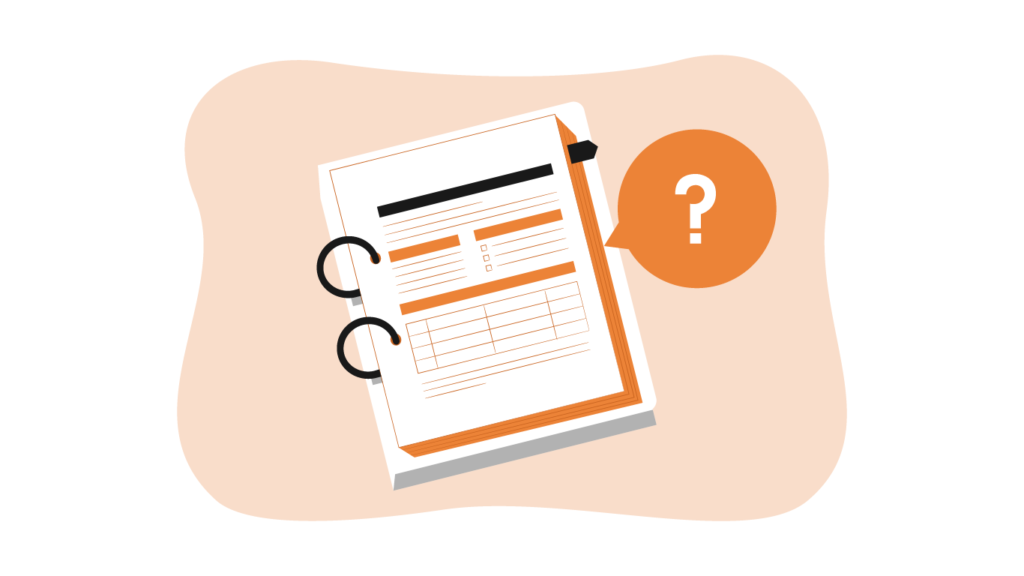
How to Write an Incident Report
It is important to lay out an incident report clearly and concisely with all the relevant information about what happened. The clearer it is to read, the easier it will be to understand the cause of the workplace accident.
The language used for incident reporting should not be too emotional and should not purposefully put the blame on someone. Here is an incident report example template:
This workplace incident report template includes the basic guidelines and best practices of what to include to make sure the report includes all the details it should. Once a report is written, it should be kept on record in the workplace.
Incident Report Examples
Depending on the type of workplace incident, the writer will need to include various pieces of information. If you are not sure how to write an incident statement, here are example incident reports for the workplace covering various scenarios.
Injury Incident Report Example
“At 11.20am on Tuesday 7 th July 2020, a worker, Timothy Johnson, tripped over an electrical wire on the Blue & Green construction site, located on Main Street, Riverside. He was carrying a hammer at the time.
It is believed the wire should not have been stretched across the ground without safety tape securing it to the ground and drawing attention to it. Timothy fell to the ground and dropped the hammer but did not injure himself with it. He twisted his ankle, which immediately began to swell and scrapped the side of his leg in a minor way. A co-worker came to assist Timothy to his feet and helped him walk to a nearby bench. Timothy could not put his weight on his left foot, so he was taken to a nearby hospital. Once at the hospital, doctors confirmed that Timothy had sprained his ankle and would have to keep the foot elevated and use crutches for the next two weeks. He would not be able to work during this time.
The foreman for the construction site has assessed the wires on the ground and concluded that brightly colored tape should secure the wires to the ground to draw attention to them and to ensure there are no bumps in the wire that are easy to trip over so that this does not happen again”.
Forklift Accident Report Sample
“On Friday 5 th July 2020, at 3.35pm, a forklift driver, Max White, was driving the forklift he usually drives in the Sunny Side Warehouse, ABC Street, when the front right tire got caught on a piece of wood on the ground, causing the forklift to overturn with Max inside it.
Luckily a co-worker was nearby to help Max climb out of the right side of the forklift. Max was shaken up and reported that his left shoulder and left side of his neck were hurting him from the impact. Max decided he did not need to go to the hospital as he felt like he would only obtain bruises from his injuries and that they were not severe enough to need medical attention. His manager sent him home for the rest of the day to ensure he did not strain himself further.
The wood that caused the forklift to overturn had not been stacked properly and has now been moved to a secure location in the warehouse to make sure it does not cause any more issues for forklift drivers”.
Fall Incident Report Sample
“In Fairview Boutique on Friday March 6 th , 2020, Samantha Wright was stacking shelves while standing on a ladder in order to reach the top shelf of handbags at 4.10pm. As she was stretching to place a bag on the shelf, the ladder collapsed from under her and she fell to the ground. Her co-worker heard the loud noise and immediately helped her. Samantha was in a lot of pain and could not get to her feet as she felt lightheaded. An ambulance was phoned, and she was brought to hospital. Samantha obtained a broken right arm, bruised thigh and hip, and a bump to the head that left no major head injury. She was recommended three weeks off work at the minimum by doctors. The fall was concluded to be of nobody else’s fault but was put down to Samantha accidently overreaching instead of moving the ladder to where she needed to see”.
Hand Injury Incident Report Sample
“On April 21 st , 2020, at Willow Maintenance, Yellow Abbey Grove, Kyle Jenkins was about to use a miter saw to cut some timber, but when he started to use the saw, it jolted, causing the saw to come down suddenly on his hand.
Kyle’s left thumb was cut deeply by the saw and he lost a lot of blood. Co-workers came to his aid, turned the saw off and helped him stop the bleeding with tissues. He was then brought to the hospital where he received eight stitches and was told to not use the hand for rigorous work for 4 weeks. The head of Willow Maintenance inspected the saw to check for any issues and see why it came down and cut Kyle’s hand. It appeared that whoever was the last person to use the machine did not put the safety latch back on the saw once they had finished using it.
If this safety latch was on the saw when Kyle used it, it would not have cut his hand, but rather, automatically shut off once it jolted. The manager decided to take a day to retrain his staff to ensure they adhere to the health and safety guidelines of the company”.
Exposure Incident Report Sample
“In Woodbell factory, Springville, on Tuesday May 26 th , 2020, Annie Bedley was packaging household cleaning products when a bottle tipped over onto her wrist.
She got up from her seat to wash off the chemical in the washroom. She then went to her supervisor to show her what had happened. Annie’s wrist was red and itchy but was not burning as she had washed off the remnants of the chemical immediately. Annie’s supervisor brought her to the office to sit with a cold compress on her hand and applied a layer of ointment to treat the burn. Annie did not feel like she would need further medical assistance and agreed with her supervisor that she would need two to three days off work to ensure the burn did not get irritated.
Annie was wearing appropriate PPE at the time of the incident and no faults were found on the conveyor belt at the packing bay. The incident has been noted as an accident with nobody to blame. Photographic evidence of the burn has been included in this file”.
First Aid Incident Report Sample
“On Friday November 15 h 2019, Arthur Stokes was walking along the corridor between building four and five of Graygrock Inc. when he noticed that there was something sharp sticking through the bottom of his right shoe.
He stopped to see what it was and found a nail stuck in his shoe. He took his shoe off and lucking was able to pull the nail out as it hadn’t pierced through to his foot and only minorly scraped it. He saw the stairwell was getting new handrails fitted and presumed the nail came from that. He saw two other nails further along the corridor and decided to pick them up to make sure nobody else stood on them. He reported to his manager’s office where he presented the nails and explained the situation. His foot had a small cut, so Arthur’s manager gave him an anti-septic wipe and a band-aid to help him.
Arthur returned to work while his manager talked to the construction workers about keeping their workspace neat and to prevent any further accidents like this from happening”.
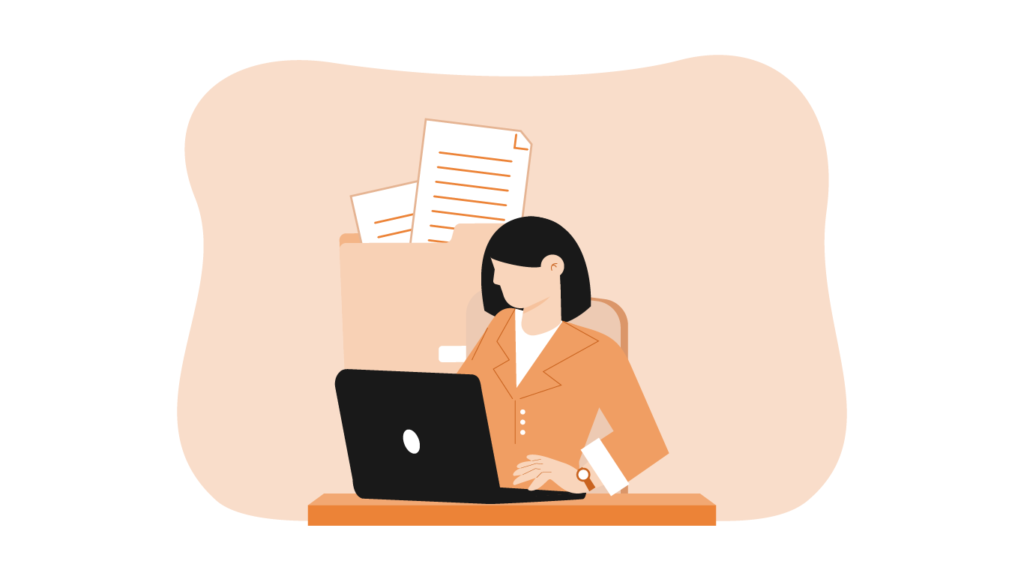
Incident Report Form Templates
The layout of an incident report forms can vary depending on where the incident took place and the type of injuries. Here are some examples of incident reports at the workplace that you can use.
Incident Report Form for General Staff (Word/PDF)
This general staff accident report form template can be used in a variety of workplaces. It includes all the necessities to describe a workplace incident to ensure it is recorded correctly. This general form is ideal for any business type.
Incident Report Form for a Construction Site
This example incident report for the workplace is unique to others as it includes a field for the construction project name and the project manager’s details. This makes it easy to understand where in the construction site the accident occurred and how severe it was.
Incident Report for a Hospital/ Medical Clinic (Word/PDF)
The hospital incident report template is much more detailed than others as it must include accurate information about the staff member or patient’s injuries, where in the hospital it happened and what medical treatment they required.
As you write your workplace incident reports, remember it is not to place blame on one person, but rather record a series of events that have taken place. Sometimes these are pure accidents due to bad luck and, sometimes, there is human error or a technical fault involved. By the way, this is the basis of the Just Culture Algorithm™ which is definitely worth exploring if you’re looking to improve the safety culture at your workplace .
These examples of incident reports at the workplace are only the tip of the iceberg when it comes to the variety of workplace accidents that can occur. In any case, it’s crucial to record any incidents that arise because this helps create a safer work environment.
References & Further Reading
- OSHA’s Guide for Employers carrying out Incident Investigation
- OSHA’s Injury & Illness prevention Program
- Workplace Injury Information
- Eyewitness Statement Form : Should be included for any eyewitnesses to the incident to aid the investigation.
- Injury Investigation Questions : Should be asked when an employee has been injured at the workplace to understand exactly what happened.
- Incident Investigation Flowchart Procedure: A step by step example of the procedures involved in carrying out a workplace incident investigation.
Related Posts
The 18 near miss reporting examples you need to know.
Type above and press Enter to search. Press Esc to cancel.
How Do You Write a Slip and Fall Incident Report?
Table of contents, how to write a slip and fall accident report, slip and fall example scenario, slip and fall accident report example, tips on writing a slip and fall accident report, what to include in your demand letter, why you should talk to an attorney, additional resources.
If you have been injured in a slip and fall accident at a business, you may be able to get compensation for your injuries. An attorney will be able to help you to figure out if you have a claim due to your injuries, and he or she will be able to guide you going forward on a claim.
After your slip and fall accident, the establishment may ask you to fill out an accident report form. You should do this, but it’s important to have your own accident report that you can keep for your own records.
Create your own accident report form using the same information that you filled out for the store.
A slip and fall incident report needs to include all the essential information about your accident. There are several accident report forms that you can find online.
The Occupational Safety and Health Administration (OSHA) requires that businesses have proper slip and fall incident reports readily available for you to fill out. Also, you can create your own or have one drafted by an attorney.
An incident report for a personal injury claim should include all the essential information about the incident. It should be accurate and factual and be supported by facts that can be proven. Photos, videos, diagrams and witnesses statements can be included as supporting evidence to show how the incident took place.
The key information that can be included in an incident report should include the following:
- your name and contact details;
- name and address of specific location of the incident;
- time and date of the incident;
- the names and contact details of those involved;
- the types of injuries and their severity;
- the names and contact details of witnesses;
- the treatment administered for the injury;
- the list of property damaged (if applicable).
- a police report if a police officer was called to the incident.
When the key details about the incident have been completed a short description should be written about the incident. For example:
“On Monday morning at 9 am you entered a store and slipped and fell on a hazard which you didn’t expect to be there. This was some liquid that had spilled out of a container which had been knocked on the floor. In just a few seconds a worker came to your assistance and it was discovered that you couldn’t move your leg which you had hit on a nearby shelf when you fell. Immediately an ambulance was called and the store manager was told about the incident. You were then taken to hospital to receive the treatment you required.”

Slip and fall accidents are common, and they can lead to serious injuries and various damages. If you have been involved in a slip and fall, an accident report will need to be completed. This accident report will serve as the foundation or basis of your personal injury claim for your slip and fall damages.
When there is a slip and fall accident, you must be very detailed in explaining what happened. You cannot just say you slipped and fell.
You must be able to provide an accurate sequence detailing what happened, how it happened, and why it happened. Here is an example of a scenario in which you suffered a slip and fall:
On Saturday morning, October 19, 2019, at 9 a.m. you entered Smith Brothers IGA in Bedford with the intention of getting groceries. You had selected a few items already when you made it to the produce department.
At the produce department, you reached to get a bag to put some individual apples in when you slipped. As you slipped, you tried grabbing onto the cart handle and the side of the cooler, but you were unable to catch yourself. You fell backward, your head hitting the side of the produce cooler and your back landing on the hard tile floor.
You felt a shooting pain that went down the center of your back. It shot across the kidney area and then went down into the legs. You felt shooting pains and numbness at the same time. The pain radiated up your neck and into the back of your head.
At this time, a produce employee ran over to check on you and at that time, you said you were unable to get up from the fall. A couple of other store employees ran over, and at that point, an ambulance was called.
As the paramedics got you up off the floor, they noticed there were squashed pieces of produce that had apparently been dropped on the floor. They appeared to have been grapes. You had stepped on these grapes and they had caused you to slip.
As soon as the grapes were mentioned, a manager ordered the employees to clean up the mess and to place a wet floor sign in the vicinity. Clean-up had commenced as you were being wheeled out of the grocery store.
When you arrived at the hospital, they took you back right away. The treating physician ordered x-rays and an MRI so they could determine the problem and the severity of your injuries. They determined there was a damaged disc and it was pressing on the nerves in your spine, which was causing the symptoms to radiate throughout your back, neck, and legs.
For more information on a slip and fall accident, visit Is a Fall Considered an Accident?
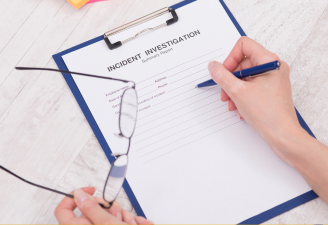
If you slipped and fell on another party’s property regardless if the property is commercial or residential, you have the right to seek compensation to pay the expenses that are associated with your injuries. First, you file a claim with the other party’s insurance company. If the insurance company refuses to pay the compensation you deserve, then the next step involves filing a personal injury lawsuit against the other party.
The key to getting an insurance claim approved and/or receiving a favorable judgment for a civil lawsuit is to complete an accident report. If you slipped and fell at a business, the owner or a manager of the business is responsible for completing an accident report. However, you should complete one as well to ensure you present your version of events.
Here is an example of a slip and fall report:
Date of Incident
October 19, 2019
Business Name and Contact Information
Smith Brothers IGA
Description of the Incident
On Saturday morning, October 19, 2019, at 9 a.m. in Smith Brothers IGA located off State Street in Bedford, the customer slipped and fell because of squashed produce – believed to be grapes – on the tile floor in front of the cooler. When the customer fell, a nearby produce department employee, Mr. Luke Brown who was putting out bananas on the rack in the center of the produce department, immediately went over to offer assistance. After assessing the situation and talking with the customer who fell, determined that the back injury was preventing the customer from getting up out of the floor. An ambulance was called, and store management was notified. Assistant Store Manager Joe Adams and Front End Manager Becky Jackson went to aid the accident victim.
The customer said she was grocery shopping and reached to get some apples when she suddenly slipped. She said she tried to prevent falling by using her hand to catch on the side of the cooler and on the buggy handle, but she was unsuccessful.
Treatment of Injuries
The customer complained of pain in the center of the back and the lower back area that radiated into the arms, legs, neck, and the back of the head. She was taken by the local ambulance service to the emergency room at a nearby hospital. After the customer was loaded onto the stretcher by paramedics, mashed fruit and a wet area were found on the floor. The produce department employees under the direction of Mr. Brown cleaned up the area and placed a wet floor sign.
Sarah Browning
Rachel Adams
The slip and fall report example gives you an idea about the types of information you need to submit for an insurance claim, as well as a civil lawsuit if your case reaches that stage of the legal process. Remember to sign and date the form because the accident report represents the document the state uses to start the clock on the filing of a lawsuit. Document every interaction with the employees of a business and the people you interacted with if you slipped and fell while at a residential property.
Never reveal any information pertaining to your case until you speak with a personal injury attorney. A slip and fall personal injury lawyer will advise you on how to move forward by filing an insurance claim and possibly a civil lawsuit.
Before writing your slip and fall accident report, you will need to gather all the necessary information. Here are some tips on how to gather that information:
Take Photos of Your Injuries
In a slip-and-fall incident, photos are the best evidence. Luckily, nowadays the majority of people have smartphones with cameras. Take pictures of the hazard that caused the accident. If there is water or another solution on the floor, take pictures of the floor area.
Take pictures of your injuries. If possible, call your doctor’s office to make an appointment immediately. When you see your doctor, ask for medical records that connect your injury to the accident. Any helpful information from the photos and the medical records should be used in your accident report.
Inspect the Area Where You Fell
Slip and fall accidents happen because there was a hazard that you were not aware of. Because of this, it's a good idea to look around the area to pinpoint exactly what caused the slip and fall. This could be anything from a wet floor, a loose carpet, or food that was spilled.
You should write down specific details in the slip and fall incident report. This will help clarify what happened before, during and after the accident, as well as verifying how your injuries occurred. It can be used to help an attorney decide how to proceed with the case.
It could also serve as evidence in court. It can be used to help an attorney decide how to proceed with the case.
Find Your Witnesses
Ask anyone who was in the vicinity of the incident to be a witness. Collect the first and last names, phone numbers and addresses of anyone who is willing to be a witness. While people who saw the accident are best, others in the area can testify on the hazard that caused the accident, along with your condition afterwards.
The names and contact info for these people should be used in your accident report. Give this information of witnesses to your attorney.
A demand letter is a letter that you write to your insurance company to negotiate a monetary settlement after an injury suffered from a slip-and-fall. These forms should have a certain amount of information to be successful. There are templates for this letter that can be found online.
In your letter, you should discuss:
- The details of the accident
- Your injuries
- The reasons for the other party being at fault
- Income losses
- Medical treatment and costs
- Any other losses
- The sum that you are requesting
- Environmental conditions (e.g. slippery floor, inadequate lighting, noise, etc.)
- Circumstances surrounding the accident (tasks, equipment, tools, etc.)
- Type of treatment needed for injuries
It is crucial to contact an attorney right away if you are injured. This is important for many reasons. Witness testimony will be easiest to get and most accurate right after an accident. Any injuries will be able to be directly tied to the accident and will be fresh. Additionally, the business will not be likely to have a defense for the accident.
But the biggest reason is due to the statute of limitations, or SOL. This is the time that you have to file your claim. After this time is over, you may be banned from filing the claim. The SOL varies depending on state.
Nonetheless, if you have been injured in a slip and fall accident, you should contact a personal injury attorney immediately to determine whether or not you have a case.
Through a personal injury claim, you may be able to recover compensation to cover the damages that you suffered, such as medical bills, lost wages, pain and suffering, and so forth.
Personal injury lawyers work on a contingency basis, which means that you don’t have to pay anything upfront or out of pocket. Instead, your lawyer isn’t paid unless you win your claim and recover compensation through a judgment in your favor or receive a settlement.
Complete the Free Case Evaluation Form to get connected with an independent personal injury attorney who subscribes to the website and may be able to help with your case.
For more information on hiring an attorney, visit Should You Hire a Lawyer for a Slip and Fall Injury Case?
- Ask the Attorney: Answers to Your Personal Injury Questions
- Steps to Take When Filing Your Personal Injury Claim
- Determining Lost Wages in a Personal Injury Claim
- Upcoming Issues
- Archive Issues
- Press Releases
- Case Studies
- Industry Reports
- Research Insight
- Techno Trends
- White Papers
- Health & Wellness
- Organizations
- Target Market
- Target Audience
- E-Newsletters
Featured News
Transforming pathology labs: the role of laboratory information systems in hospitals, hospital discharge care intervention reduces readmissions, healthcare ai transparency – onc finalises sweeping rule, infrared imaging making its mark in remote patient tracking, providers can look up to change to issue data breach alerts, nhs cyberattack – ongoing ransomware risk to healthcare, realising ai’s potential in healthcare, modernizing diabetes care: the convergence of cgms and ai in treatment…, increasing emr system satisfaction through personalisation, intersystems expands the intersystems iris data platform with vector search to…, meeting patients’ digital expectations with systems that put safety first, latest press releases, research on parents know-how of vaccination in children, a paper of significance: high occurrence of hemophilia in us, siemens healthineers announces £250m oxford facility, the uks first major production site for new mri cooling technology, omnicell transforms the point-of-care medication management in the middle east, featured press releases, intersystems and ecosystm study reveals data synergy would improve analytics insights…, intersystems reimagines clinician workflow with trakcare assistant, greiner bio-one celebrates its 60th anniversary.
- Knowledge Bank
How do you write a slip and fall incident report?
Slip and fall accidents can occur relatively anywhere. As a product of the environment and the lack of one’s own personal awareness, slip and fall accidents might infer that their only liability is yourself, but that is often not the case. When you are visiting an area or a private property maintained by someone else, you may be able to seek injury compensation in response to their failure to maintain a safe environment if an accident has occurred. A premises liability claim can then be issued against the property owner, landlord , or figure of authority to accurately compensate for lost workdays and high medical costs. If you wish to prove and hold someone at fault, you need to write a slip and fall incident report. If you are looking to defend your claim in the court of law, consider Fresno Slip and Fall Accident Lawyers .
A slip and fall incident report includes all the necessary information about your accident. It is a mandatory report needed to facilitate the ability of compensation for your injuries.
Report framework
Before you contact an attorney, it is crucial that you have a proper outline detailing the incident that you can use for reference. It is easy to find fault in a slip and fall case, but backing it up with evidence requires that you recount and note the details of the incident as quickly as possible so that crucial factual items of note are not forgotten. Finding a report outline example online is quite easy – you should choose one that relates best to your situation, and add to it depending on the complexity of the case. Make sure to consider the statute of limitations if you wish to file a lawsuit or receive injury compensation. Act fast contact the property owner or person in charge of the maintenance to see if the issue can be rectified in a civil manner.
Alternatively, if you have suffered from an injury in a business location, the Occupational Safety and Health Administration (OSHA) necessitates that all businesses require proper slip and fall incident reports that you can fill out at the ready. While this makes the incident report much more accessible, it is, however, still essential that the incident is reported to an attorney if you wish to seek proper legal action.
Content and prerequisites
Slip and fall cases are in no way a jovial manner. They comprise over 8 million hospital visits annually, totaling to one in five of every annual hospital visit. Slip and fall cases are a question of when, not if. Their severity increases exponentially by age, and are the leading cause of missed workdays.
When writing a slip and fall report:
- Recount the details of the incident (date, time, location, activity in question, cause of fall, etc.);
- Inspect the location of the fall, including environmental conditions and any other special circumstances involving the accident;
- Retrieve evidence of injuries (photos, hospital reports, etc.), including medical expenses, income losses, and other incidents of suffering;
- Inform witnesses, follow up on their narrative;
These are the main details of a slip and fall incident report, but your attorney may ask for you to provide additional information depending on the circumstance of the accident. For example, is important to note whether you were visiting the property or area in question legally, and were allowed to be there in the first place.
Most importantly, you should remember that a slip and fall case is necessary to be resolved so that the environment is better prepared and safer for other people and that your injuries are fairly compensated for by the person at fault of the accident.
RELATED ARTICLES MORE FROM AUTHOR
Recent posts.
Select Country Algeria (+213) Andorra (+376) Angola (+244) Anguilla (+1264) Antigua & Barbuda (+1268) Argentina (+54) Armenia (+374) Aruba (+297) Australia (+61) Austria (+43) Azerbaijan (+994) Bahamas (+1242) Bahrain (+973) Bangladesh (+880) Barbados (+1246) Belarus (+375) Belgium (+32) Belize (+501) Benin (+229) Bermuda (+1441) Bhutan (+975) Bolivia (+591) Bosnia Herzegovina (+387) Botswana (+267) Brazil (+55) Brunei (+673) Bulgaria (+359) Burkina Faso (+226) Burundi (+257) Cambodia (+855) Cameroon (+237) Canada (+1) Cape Verde Islands (+238) Cayman Islands (+1345) Central African Republic (+236) Chile (+56) China (+86) Colombia (+57) Comoros (+269) Congo (+242) Cook Islands (+682) Costa Rica (+506) Croatia (+385) Cuba (+53) Cyprus North (+90392) Cyprus South (+357) Czech Republic (+42) Denmark (+45) Djibouti (+253) Dominica (+1809) Dominican Republic (+1809) Ecuador (+593) Egypt (+20) El Salvador (+503) Equatorial Guinea (+240) Eritrea (+291) Estonia (+372) Ethiopia (+251) Falkland Islands (+500) Faroe Islands (+298) Fiji (+679) Finland (+358) France (+33) French Guiana (+594) French Polynesia (+689) Gabon (+241) Gambia (+220) Georgia (+7880) Germany (+49) Ghana (+233) Gibraltar (+350) Greece (+30) Greenland (+299) Grenada (+1473) Guadeloupe (+590) Guam (+671) Guatemala (+502) Guinea (+224) Guinea - Bissau (+245) Guyana (+592) Haiti (+509) Honduras (+504) Hong Kong (+852) Hungary (+36) Iceland (+354) India (+91) Indonesia (+62) Iran (+98) Iraq (+964) Ireland (+353) Israel (+972) Italy (+39) Jamaica (+1876) Japan (+81) Jordan (+962) Kazakhstan (+7) Kenya (+254) Kiribati (+686) Korea North (+850) Korea South (+82) Kuwait (+965) Kyrgyzstan (+996) Laos (+856) Latvia (+371) Lebanon (+961) Lesotho (+266) Liberia (+231) Libya (+218) Liechtenstein (+417) Lithuania (+370) Luxembourg (+352) Macao (+853) Macedonia (+389) Madagascar (+261) Malawi (+265) Malaysia (+60) Maldives (+960) Mali (+223) Malta (+356) Marshall Islands (+692) Martinique (+596) Mauritania (+222) Mayotte (+269) Mexico (+52) Micronesia (+691) Moldova (+373) Monaco (+377) Mongolia (+976) Montserrat (+1664) Morocco (+212) Mozambique (+258) Myanmar (+95) Namibia (+264) Nauru (+674) Nepal (+977) Netherlands (+31) New Caledonia (+687) New Zealand (+64) Nicaragua (+505) Niger (+227) Nigeria (+234) Niue (+683) Norfolk Islands (+672) Northern Marianas (+670) Norway (+47) Oman (+968) Palau (+680) Panama (+507) Papua New Guinea (+675) Paraguay (+595) Peru (+51) Philippines (+63) Poland (+48) Portugal (+351) Puerto Rico (+1787) Qatar (+974) Reunion (+262) Romania (+40) Russia (+7) Rwanda (+250) San Marino (+378) Sao Tome & Principe (+239) Saudi Arabia (+966) Senegal (+221) Serbia (+381) Seychelles (+248) Sierra Leone (+232) Singapore (+65) Slovak Republic (+421) Slovenia (+386) Solomon Islands (+677) Somalia (+252) South Africa (+27) Spain (+34) Sri Lanka (+94) St. Helena (+290) St. Kitts (+1869) St. Lucia (+1758) Sudan (+249) Suriname (+597) Swaziland (+268) Sweden (+46) Switzerland (+41) Syria (+963) Taiwan (+886) Tajikstan (+7) Thailand (+66) Togo (+228) Tonga (+676) Trinidad & Tobago (+1868) Tunisia (+216) Turkey (+90) Turkmenistan (+7) Turkmenistan (+993) Turks & Caicos Islands (+1649) Tuvalu (+688) Uganda (+256) UK (+44) Ukraine (+380) United Arab Emirates (+971) Uruguay (+598) USA (+1) Uzbekistan (+7) Vanuatu (+678) Vatican City (+379) Venezuela (+58) Vietnam (+84) Virgin Islands - British (+1284) Virgin Islands - US (+1340) Wallis & Futuna (+681) Yemen (North)(+969) Yemen (South)(+967) Zambia (+260) Zimbabwe (+263)
- Agriculture
- Construction
- Manufacturing
- View all industries
- Case Studies
Incident Report Samples to Help You Describe Accidents

Your company’s incident report form should make it easy to record the details of a workplace accident. Even fill-in-the-blank forms require a long-form description of the incident. This portion of the report can be the most difficult part to write.
In this article, we provide completed incident report samples to help you hone your documentation skills.
What Does an Incident Report Need to Include?
An incident report is a formal recording of the facts related to a workplace accident, injury, or near miss . Its primary purpose is to uncover the circumstances and conditions that led to the event in order to prevent future incidents.
Every incident report you file should contain a minimum of the following:
- Type of incident (injury, near miss, property damage, or theft)
- Date of incident
- Time of incident
- Name of affected individual
- A narrative description of the incident, including the sequence of events and results of the incident
- Injuries, if any
- Treatments required, if any
- Witness name(s)
- Witness statements
- Other workers involved
- Video and/or 360-degree photographs of the scene
Include quantifiable measurements where possible. For example, the ladder capacity is 250 lbs and the victim was hoisting 300 lbs.
Finally, where more than one person is injured in an incident, create a unique report for each affected employee . While it’s fine to duplicate general details between reports of this nature, you’ll need to include details specific to that person, such as the event from their point of view or medical records.
When Does an Incident Report Need to Be Completed?
Create an incident report as soon as your employees are safe , which includes seeking medical attention and implementing an immediate corrective action to prevent further danger or damage.
By recording details immediately, you improve the accuracy of your report and the effects of your corrective actions. While it may take a few days to complete your report, it should take you only hours (or less) to start it.
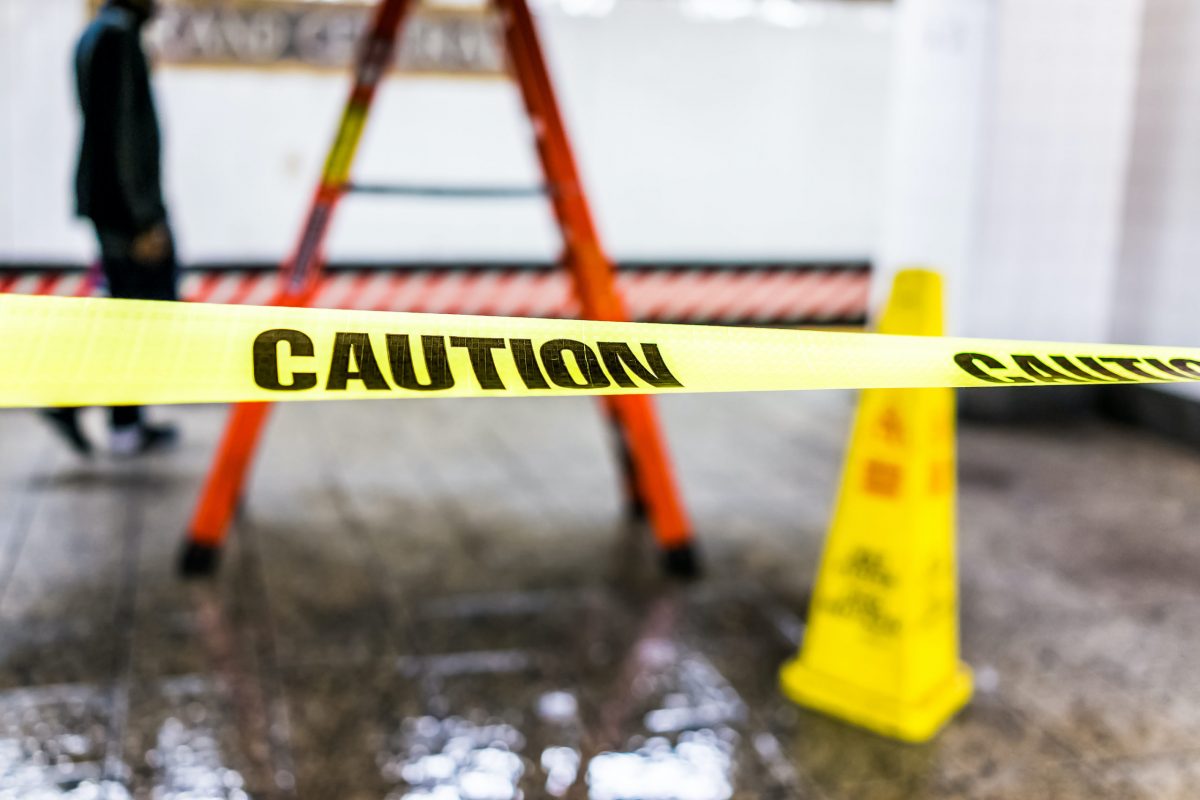
Depending on your company policies and oversight from relevant regulatory bodies, you may be legally bound to complete an incident report within a given amount of time. If the incident resulted in a recordable injury, you must complete OSHA Form 301 within seven days. In addition, you may need to send your report to the organization providing oversight, US Federal or State OSHA , for example, within a given period of time.
Review federal OSHA incident reporting and recordkeeping requirements or visit your state OSHA website for details. Remember that you must also report a fatality, hospitalization, or amputation directly to OSHA.
Safety Management Tip : Safesite Premium users enjoy streamlined OSHA incident recording with Safesite’s OSHA300 log integration feature .
Incident Reporting Mistakes to Avoid
Incident reports are more than a mandatory form to complete: they’re a vital part of your recordkeeping practices both for compliance and safety in general. Their importance means you want to get as much relevant information as you can as quickly as possible. But sometimes, safety teams can get in their own way and miss out on important details by making common mistakes.
Blame-casting and just getting it done are two common incident reporting mistakes you should avoid.
It is easy to go on a witch hunt when accidents happen. However, incident reports aren’t created for the purpose of finding out who’s to blame. While staff should be held responsible (as stipulated by company policy) when they knowingly endanger themselves others, an incident report should focus on improving workplace safety.
If you make it clear you’ll abide by company policy but are not out to cast blame, you increase the likelihood that employees will participate in your incident investigation and provide honest witness statements. These factors create a stronger incident report.
In addition, if you rush through the report to “just get it done,” you may miss out on important details or lack clarity in wording. Irresponsible reporting can lead your team into even more danger, while detailed, clear reporting can lead to improved work conditions and better training.
Three Incident Report Samples
Below are some sample incident report formats for three common types of workplace accidents. Use them as guides to effectively describe events.
Injury and Lost Time Incident Report Sample
If an injury requiring medical treatment, lost time/altered responsibilities happens in your workplace, it’s important to document it ASAP while the details are still fresh in memory.
Here are some of the vital elements to include in your description of the incident:
- Location (Address)
- Date/time of incident
- Name of supervisor
- Description of the incident, including specific job site location, the sequence of events, and the results of the event
- Whether or not proper PPE was being used
- The root cause(s) of the incident
- Associated hazards raised and resolved following the event
- The affected individual’s version of the events
- Actions taken by concerned individuals after the incident
- Description of injuries
- How the decision was made to call (or not to call) emergency services
- Treatment required
- Photographs of the scene
Though the details above seem excessive, mentioning them in the incident report paints a more accurate picture. It’s important to include the above information in as detailed and concise a manner as possible. Holes in your report could lead to inferences and missed opportunities to create a safer workplace.
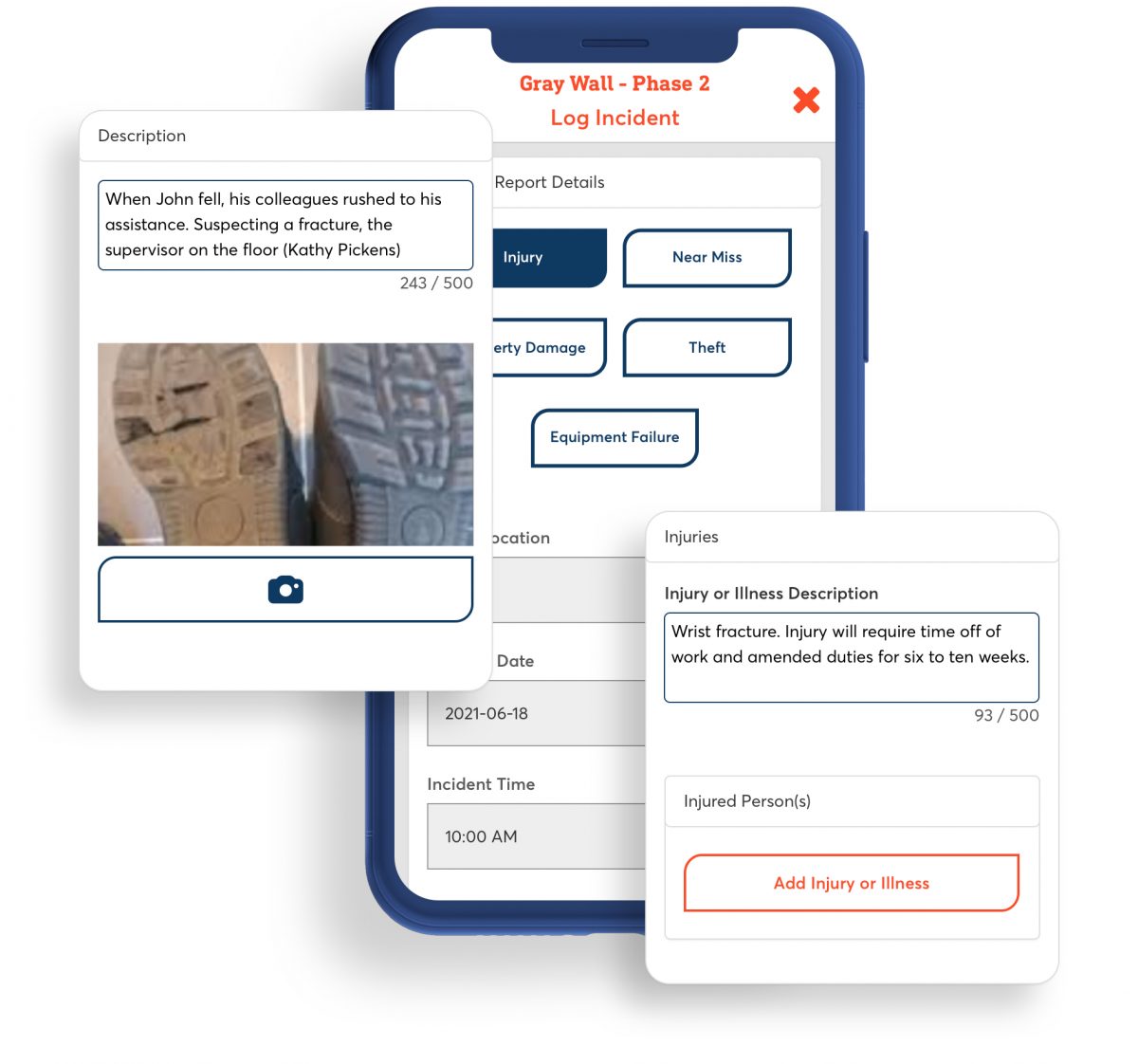
To write an incident report, use a narrative format. In other words, simply tell the story. Here’s an incident report sample description of a slip or fall resulting in a fracture, written in narrative form:
“On Friday afternoon, February 3, 2019, at 2 p.m. in ABC Shipping Co. located in 13th Avenue, Applewood, one of the warehouse workers (John Keegan) slipped and fell while carrying heavy (85 lbs) inventory. The root cause is believed to be the unavailability of a hand truck or pallet jack. Instead of waiting, John attempted carrying the load himself. A second possible cause is the condition of John’s PPE, specifically his boots, which are very worn in certain places.
When John fell, his colleagues rushed to his assistance. Suspecting a fracture, the supervisor on the floor (Kathy Pickens) decided to call 911. John said he felt a bit dizzy when he lost his balance and that he just ‘tripped over his feet.’ He tried to minimize damage to the load itself while falling, which may have led to a more awkward fall.
Two of his co-workers said that they noticed he was struggling a bit before the fall, but were busy with their own tasks and felt it would be rude to ‘call him out.’ See the attached witness statements for more info.
John was taken to a nearby hospital and a fracture to his wrist was confirmed. John will be out of work for a number of weeks.
The supervisor is currently working with the safety officer (Chris Darnell) to assess the condition of the floor, the number and condition of hand trucks and pallet jacks on the floor, as well as the condition of company-provided boots over two years old.”
As you can see, including the full story, complete with small details and witness statements will help you investigate and recall the incident with greater clarity.
After documenting the incident, you may have legal reporting requirements. Report and store the files according to recordkeeping requirements from regulatory bodies. It’s generally best practice to preserve the files for the duration of employment.
Exposure Incident Report Example
When exposure to dangerous chemicals or pathogens occurs, it’s important to document the event carefully in an incident report.
Including the following details will make your exposure incident report more effective:
- Name of affected individual
- Name of Supervisor
- Description of the incident, including specific job site location, sequence of events, and results of the event
- Name of the chemical/pathogen/carcinogen, amount, concentration, and description of hazard labels/safety data sheets (SDS)
- Exposure monitoring data, if available
- Whether or not a contaminated sharp was involved
- Description of injuries, including body part(s) exposed, length of exposure, and size of area exposed
- Signs and symptoms displayed
- Photographs of the scene and hazard labels involved
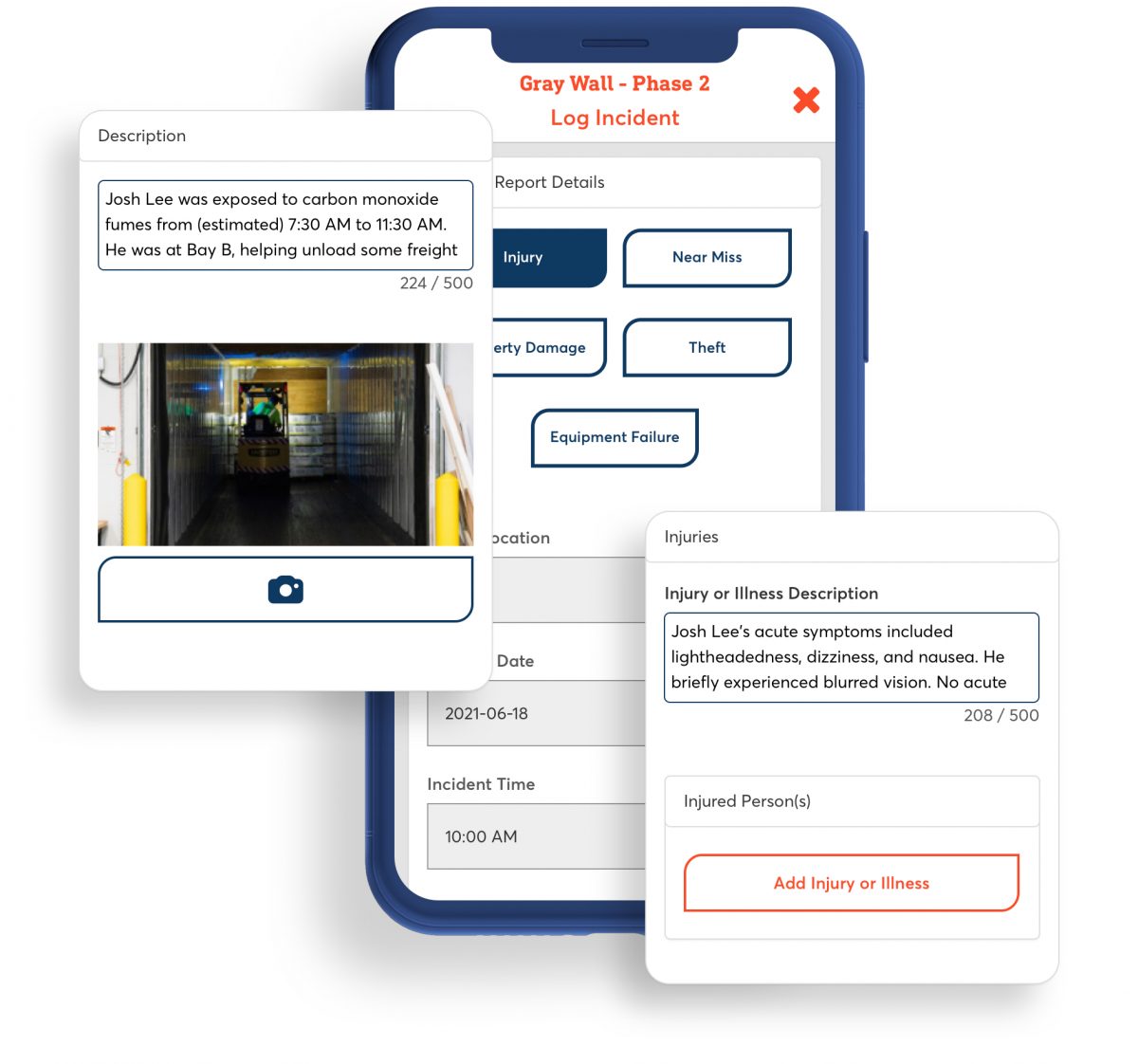
Here’s an incident report sample description for overexposure via inhalation:
“Josh Lee, a freight handler in XYZ Shipping Lines, was exposed to carbon monoxide fumes on December 2, 2017, Tuesday, from (estimated) 7:30 AM to 11:30 AM. He was at the unloading bay B, helping unload some freight from various containers with the help of two forklift operators: Kit Stevens and Donald Summers, neither of which complained of symptoms.
During unloading, Lee suddenly experienced lightheadedness and nausea. He informed his supervisor (Donna Martin) that he thought he was ill.
Martin noticed his symptoms were consistent with CO exposure, so she walked over to the area and felt the air quality seemed off. She ran a sensor (Portable Direct Reading Monitor) and discovered that CO levels were on the high end but within the acceptable limit: 30 PPM.
Stevens and Summers were ordered to turn off powered vehicles and sit in fresh air for an hour while the ventilation system could be examined (see attached report).
Lee was driven to the hospital by Martin to receive treatment. On the way, he complained of blurred vision briefly but said that it had cleared up upon walking into the ER. A full report will be attached once received.
Lee’s colleagues, Stevens and Summers, didn’t notice anything out of the norm with the air quality, but Summers acknowledged that at 11:00 AM, his vehicle had been left running near the open end of a container for thirty minutes while Lee was adjusting two improperly arranged pallets just inside. There is no air quality data from that time.”
Be sure to attach medical reports and lost-time from work, if any, to your initial report. Keep the report on hand for the duration of the employee’s tenure with the company, at a minimum.
First Aid Incident Report Sample
Some workplace mishaps result in an injury that requires on-site or walk-in medical first aid treatment. Often, workers can return and finish their shift. Recording an incident report is still vitally important, even where it’s not expressly required by regulatory bodies.
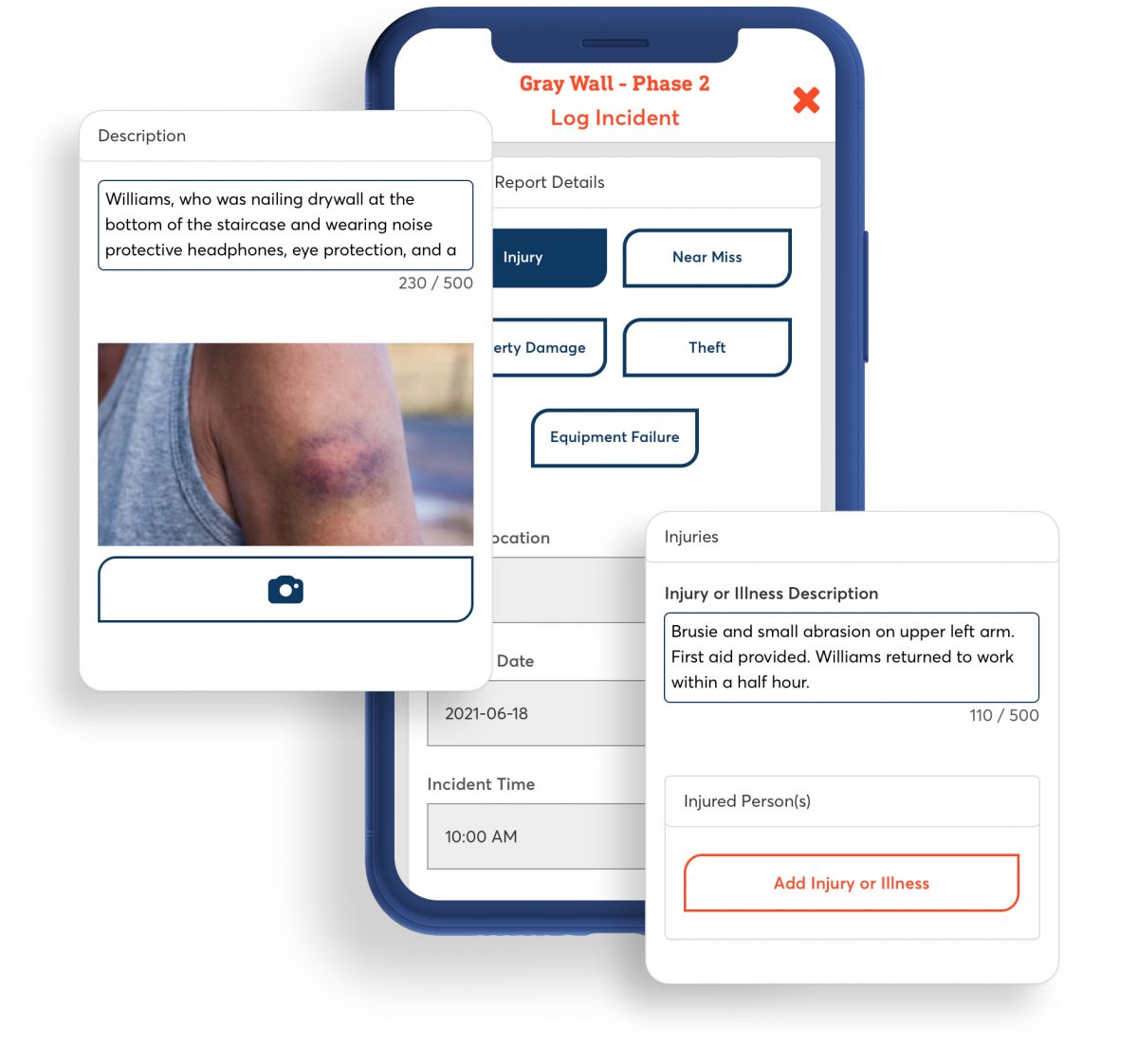
Here is an incident report sample description for incidents resulting in the need for first aid.
“ On May 12, 2019, at around 9:34 AM. at King Street job site, Michael Williams was hit by an air nail gun that had been dropped by Carl Simone near the top of a staircase and gained momentum as it tumbled down.
Williams, who was nailing drywall at the bottom of the staircase and wearing noise protective headphones, eye protection, and a short-sleeved shirt, was hit in the arm, causing a bruise and abrasion. He was treated with antiseptic, antibiotic ointment, a bandage, and an ice pack on site. Williams returned to work within a half hour.
Simone had shouted a warning after he dropped the gun, but Williams said he did not hear it. Simone said that he simply lost his grip, but Williams said he felt that the tool may have been ‘swung’ before dropping. There were no other witnesses to report on the circumstances of the accident.
Simone was wearing gloves when he dropped the nail gun. There are no outstanding hazards related to this incident and all workers will be reminded about glove selection and tool handling at the next safety meeting.”
While you should always document injuries requiring first aid internally, you typically don’t need to add them to your Form 300A or other regulatory reporting. In fact, doing so can needlessly elevate your incident rate.
An Incident Report Template to Improve Your System
Your incident reporting system should allow your employees to easily document all of the information listed in the incident report samples above. If your incident forms are easy to fill out in the field, you’re more likely to capture accurate, timely information.
With Safesite, you can complete an incident report in six easy steps:
- Tap Log Incident
- Select your inicent report type (injury, near miss, property damage, theft, or equipment failure) and location, date, and time
- Input your incident description and an incident photo
- Tag the person involved and witnesses from your team
- Complete root cause analysis
- Log your incident
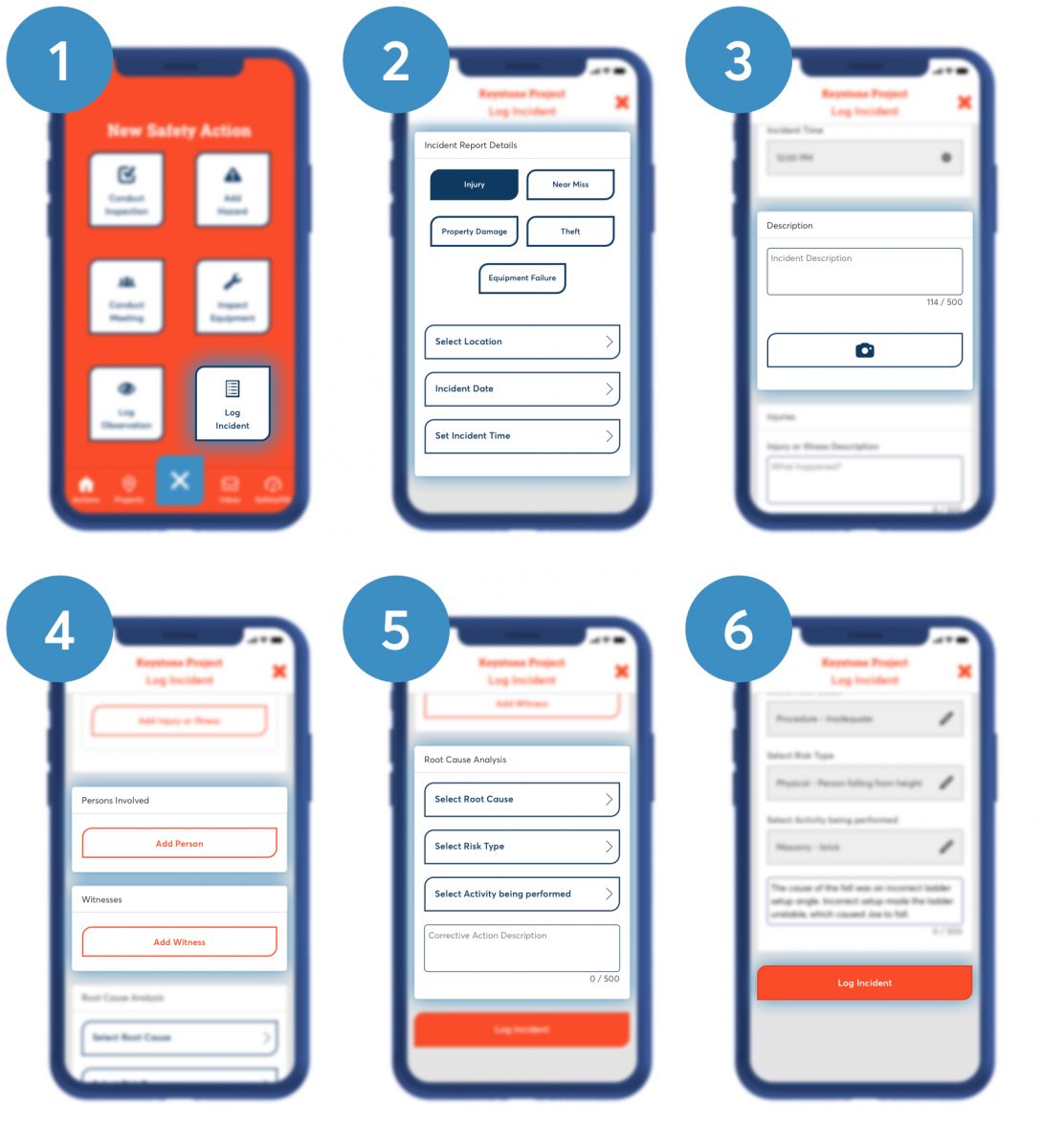
Safesite’s incident report form can be filled out on-site via iOS or Android app. It includes places to record the details of the event, images of the scene, and witness statements. It also allows you to raise associated hazards and identify a root cause.
An incident report can also be completed using paper, but many companies now look to secure software to not only document and store incidents but also to trend problem areas and reveal safety gaps.
Not ready to go mobile yet? Here’s a paper template you can edit and use in the meantime:
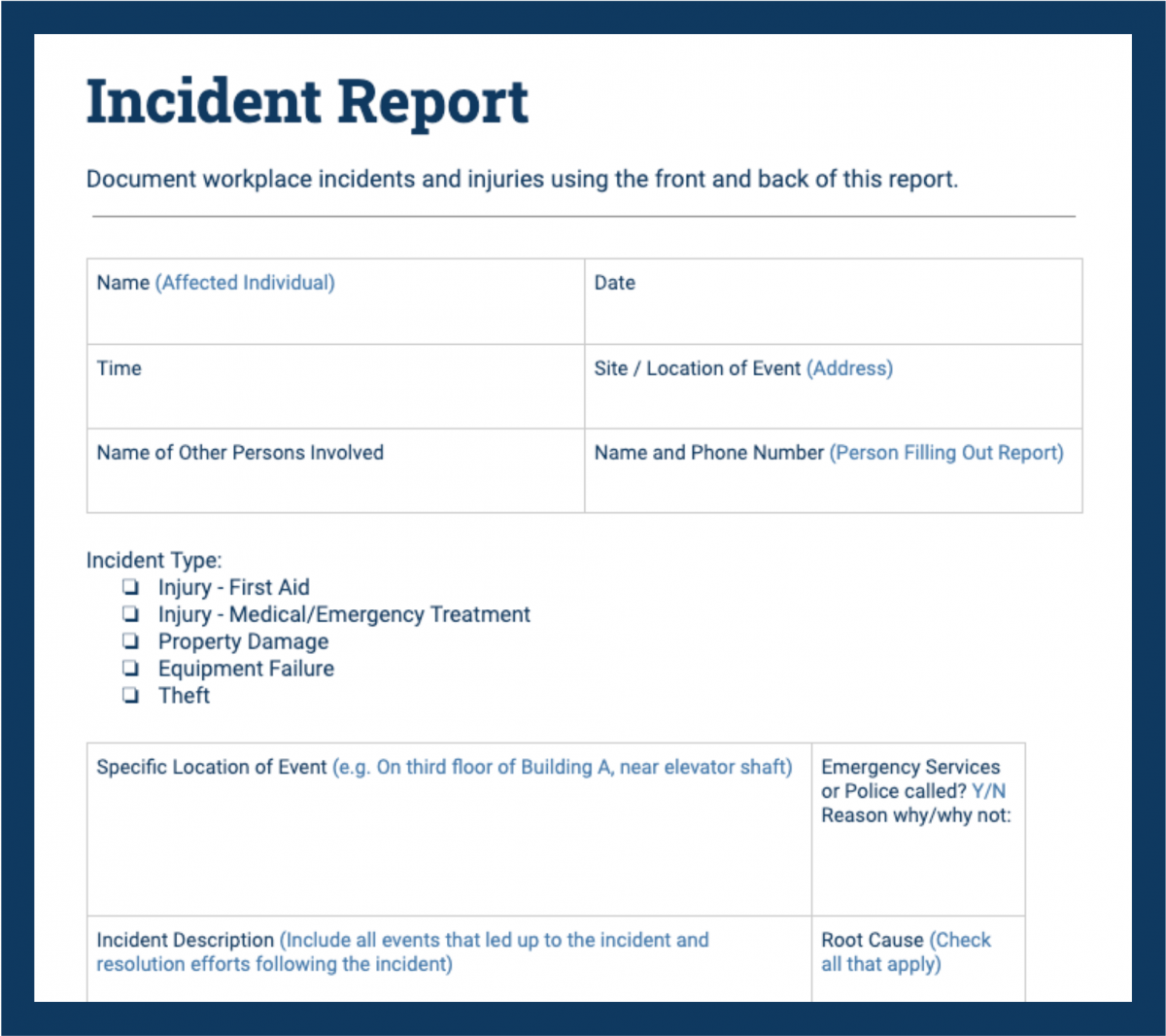
Raising and Resolving Hazards
Many incidents and near misses will involve hazards that could cause immediate or future harm to your employees if not resolved. From tagging and removing damaged equipment from service to safely dismantling corrupted structures, your incident reporting process is not truly complete until you resolve the danger.
To keep things straightforward, include hazard descriptions and actions on your incident reports. With Safesite, you can create hazards from within an incident report by tapping Add Root Cause Hazard. Then, you’ll be able to alert your team of the hazard in real-time and assign it to someone for resolution. And you can do it without deviating from your incident report.
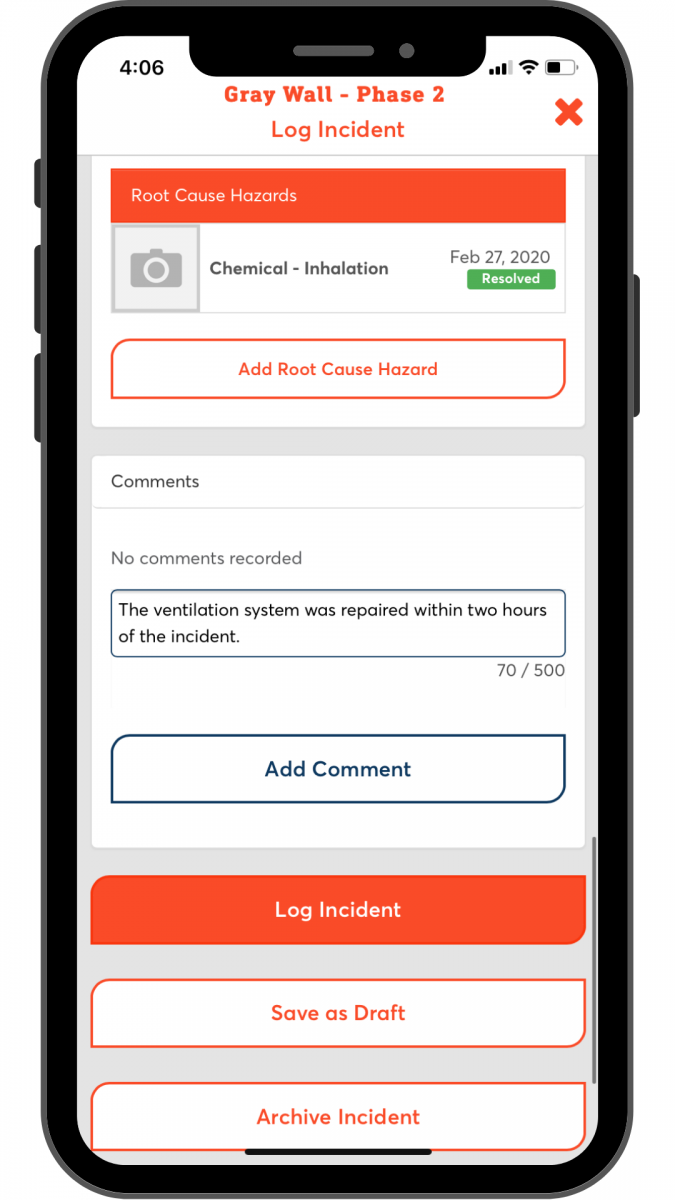
Tip: Want to streamline hazard management without missing a beat? Check out our guide to faster hazard recognition and resolution .
Go Forth and Report
When writing incident reports, be objective about the details. Your main goal is improving workplace safety, not pointing fingers at who is responsible. The incident report samples provided show that by staying true to the facts, you encourage employee participation in your investigations.
Digital reporting automates part of the process, saving you time and reducing human error. Improve your incident reporting process by using a digital reporting tool, like Safesite , that integrates alerts and hazard resolution in a single place.
- First name *
- Last name *
By Team Safesite
We're a group of safety and tech professionals united in our desire to make every workplace safer. We keep a pulse on the latest regulations, standards, and industry trends in safety and write about them here on our blog.
This article covers:
Related blog posts, why employee engagement is the key to unlocking safety program performance, everything you need to know before changing your safety software, safesite’s step-by-step guide to safety program digitization.
- Safety Management
- Leadership Development
Worksite Safety
- Frontline Fundamentals
- Train the Trainer 101
- Tailgate Topics
- Voice of Experience
- Equipment Operations
- OSHA Articles
- Industry Events
- Volume 20 - IP 2023
- Volume 19 - IP 2022
- Volume 18 - IP 2021
- Volume 17 – IP 2020
- Utility Safety in Depth
- Utility Safety Solutions
- Register for Conference
- Submit a Product Release
- Vendor Video Library
- Submit Ad Materials
- View Media Kit
- Download iP Digital App
- Tailgate Topics E-Newsletter
- Utility Products E-Newsletter
- Contribute to Promote Safety
- CUSP Certification
- Subscribe Now!

LOOKING FOR SOMETHING?
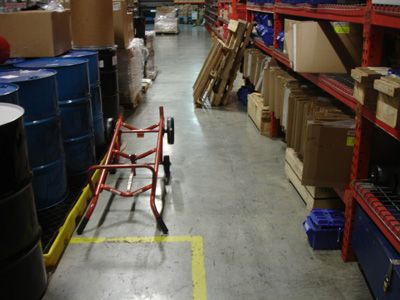
Investigating and Documenting Slips, Trips and Falls
Written by Chip Darius, CUSP, OHST, CET, CSHO on August 19, 2019 . Posted in Worksite Safety .

People are affected by gravity at every moment of their existence. There is an ongoing struggle between this planet, which never stops trying to pull things to its center, and humans who are trying not to be overcome by the pull. In the battle against gravity, humans rely on balance, coordination, traction and decision-making. In work environments, employers are responsible for managing hazards; reducing or eliminating hazards that could cause slips, trips and falls; training employees; and investigating incidents to prevent recurrence. The remainder of this article will focus on the investigation and documentation of slips, trips and falls in the utility work environment.
Terminology and Goal Clear definitions help guide us to clear outcomes, improved safety and reduced risk. People may refer to “slipstripsandfalls” as a single thing, but they are each distinctly different. Slips, trips and falls can occur alone or in combination.
The employer’s goal is to reduce risk of injuries and incidents by maintaining clean, dry, well-lit workplace walking surfaces with appropriate traction that matches the user’s expectations; managing footwear; eliminating trip hazards; avoiding slippery contamination; and training workers.
Traction refers to the friction between a surface and a person’s foot or footwear. It is scientifically described as either a static or dynamic coefficient of friction. Where there is a high-traction surface and high-traction footwear – such as a brushed-finish cement sidewalk and aggressive-tread work boots – it is less likely that a slip will occur. Contamination can change the available traction, such as when there is moisture, oil or ice between footwear and a surface.
A slip occurs when traction is not maintained and there is a loss of control over body position. On a dance floor or the surface of an ice hockey rink, lower traction is desirable. On a basketball court or workplace walking surface, greater traction is desirable. A slip may or may not involve a fall to the surface. If a person has an accurate expectation that a surface has low traction, and the person has good balance and coordination, the person often can compensate by slowing down and taking smaller, closer steps to avoid a slip. When the person is surprised because the actual traction is less than their expectation, a slip often results.
A trip occurs when a person is in motion and the foot or lower leg strikes against something. Body momentum leads to a loss of balance, which may or may not involve a fall to the surface. A stumble may occur as the person alters their gait and attempts to regain their balance. Humans do not normally high-step march but instead swing a leg forward with minimal clearance from the walking surface, so any vertical projection of a quarter-inch or more is considered a trip hazard. People can still trip even if a hazard is in view and well-marked.
There are two types of falls : a fall to the same level and a fall to a lower level. A fall to the same level occurs when a person’s center of gravity moves beyond the point of balance recovery and gravity pulls the body to impact the same surface the person is on. A fall to a lower level involves a fall from the surface the person was on and body impact to a different surface below.
Investigation Follow a standardized, recognized method to investigate slips, trips and falls. Incident investigation training is available from the OSHA Training Institute Education Centers, National Safety Council, American Society of Safety Professionals and other sources. OSHA has published “Incident [Accident] Investigations: A Guide for Employers,” which is available for free download at www.osha.gov/dte/IncInvGuide4Empl_Dec2015.pdf. The agency strongly encourages employers to investigate all workplace incidents, both those that cause harm and the close calls that could have caused harm under slightly different circumstances. OSHA recommends the following four-step investigation process, using a systems approach to identify underlying root causes:
- Preserve and document the scene.
- Collect information.
- Determine root causes.
- Implement corrective actions.
Documentation Most companies have a standard incident report for employees or visitors, and a standard first report of injury for employees. Neither form typically captures all the information needed in a slip, trip or same-level-fall investigation. In utility work, the incident may involve a worker, contractor, visitor to utility facilities or pedestrian trying to navigate a work zone.
The initial investigation tends to focus on the “big three”: the walking surface, the footwear and the contaminant. Was the surface clean, dry and clear with adequate traction? Was the footwear sole appropriate for the surface? Was there water, oil, ice, sand, food or dust present? Was the contaminant on the surface or on the footwear? A strong investigation looks well past the big three, especially if a lawsuit is possible.
Structural Issues Consider structural issues: consult building codes, fire codes, the Americans with Disabilities Act as amended, the Manual on Uniform Traffic Control Devices and OSHA standards to determine if the walking surface complied with applicable standards. Refer to ANSI A1264.1-2017, “Safety Requirements for Workplace Walking/Working Surfaces and Their Access; Workplace, Floor, Wall and Roof Openings; Stairs and Guardrail/Handrail Systems.” Consult ASTM F1637-19, “Standard Practice for Safe Walking Surfaces,” a consensus standard that applies to both new and existing walkways, sidewalks, stairs and other walking surfaces for pedestrians wearing ordinary footwear. For slips, the National Floor Safety Institute’s B101 series of standards addresses coefficients of friction and preparation of traction audit reports.
Environment Consider the environment where the incident occurred and take photos and/or videos. Did it happen indoors or outdoors? Did weather or precipitation play a role? Were temporary mats deployed and changed properly? Were there loose mats or rugs? What was the lighting like? What was the surface made of, when was it installed and was it consistently the same material throughout? How should the surface have been maintained according to the manufacturer, and how was it maintained? Was there any visible defect, damage or contaminant? Was there wear or deterioration? Was the surface sloped? Were there holes or gaps in the surface or changes in level? Were there any warning signs or indicators of the hazard?
Personal Statements and Footwear Take the written statement of the person who slipped, tripped or fell, along with the statements of any witnesses. Capture details about what happened before, at the time of and following the incident. How was the person moving? Were they standing, shuffling, walking, striding or running (straight or turning), upslope or downslope? Were they talking, texting, carrying anything, or physically or mentally distracted? Using a cane or other device? Impaired by fatigue, medication or substances? Wearing glasses or contact lenses? Did they see the hazard and try to avoid it? How far did they fall, how did they land and what body parts were injured? Who provided first aid or medical care? Photograph their footwear, including the brand and model, and the condition of the soles.
Organizational Records Examine organizational records. Have there been previous incidents or complaints related to walking surfaces in that area? What janitorial services affect the surface? When were they last provided? What products were used, and were application instructions followed? Has the surface previously been assessed for a static coefficient of friction and/or a dynamic coefficient of friction using an approved tribometer and measurement process?
Report of Findings Prepare a report of findings. The corporate safety department and/or corporate attorney should help with preparing the report. For guidance, there are excellent resources in ASTM F1694-14, “Standard Guide for Composing Walkway Surface Investigation, Evaluation and Incident Report Forms for Slips, Stumbles, Trips, and Falls.” Keep all notes, photos, sketches, statements and so forth according to your agency’s records retention policies. Consult legal counsel before altering or discarding any information if a lawsuit is possible.
Updated OSHA Standards OSHA standards establish minimum legal standards for workplace safety programs. In 2017, OSHA updated general industry walking and working surface standards, and employers now have specific duties and responsibilities. OSHA 29 CFR 1910.22 requires employers to keep walking surfaces clean, orderly, sanitary, dry to the extent feasible and free of hazards. The employer also must inspect, maintain and repair the surfaces.
OSHA 1910.22(d) requires the employer to ensure walking-working surfaces are inspected on two different schedules: regularly and as necessary. Paragraph 1910.22(d) also requires that hazardous conditions on walking-working surfaces be corrected immediately or be guarded to prevent employees from using the surface again until the hazard is corrected or repaired. Once-a-shift inspection at building entranceways may not be enough in a rain or snow event. Ongoing inspection may be required in a cafeteria food line where dropped food items can create slip hazards. Utility truck walking and stepping surfaces should be inspected each shift.
OSHA construction standards 29 CFR 1926.25, 1926.34 and 1926.250 require exit routes, aisles and passageways to be kept clear and in good repair for free and safe movement of employees and equipment.
Suitable resources must be available to guard a hazard, such as warning signs or barriers that effectively direct people safely around the hazard. Consider visually impaired employees who may not be able to see protective devices and available lighting in the area. Also consider distracted walkers who may be focused on their mobile devices rather than their environment.
Compromised Hazard Controls Routinely inspect for hazard controls that have become less effective over time. Traction tape can wear through, stair tread covers can become loose, brightly colored warning paint can fade, and warning signs can be damaged or disappear. Hazard controls show that the organization was aware of the hazard, and failure to maintain warnings will not be well-received by OSHA or a jury.
Summary A strong investigation identifies hazards and system weaknesses so that the employer can improve controls and reduce risk. Getting to the root cause or causes helps to prevent similar incidents from occurring. For a safer tomorrow, strengthen your investigation of slips, trips and falls today.
About the Author: Chip Darius, CUSP, OHST, CET, CSHO, is founder and president of Safety Priority Consultants LLC ( www.safetypriority.com ). He has provided safety consulting and training services to construction, utility and general industry clients since 1991. Darius serves on the AGC of America Health & Safety Committee and is frequently called upon as an expert witness in safety-related legal matters.
- Business Templates
- Sample Reports
FREE 10+ Sample Fall Incident Reports in PDF | MS Word | Google Docs

Nobody is perfect. Everybody commits an error or a mistake. For instance, a chef can get some ingredients mixed up, it’s hard to tell sugar from salt without a label or a taste after all. A person without prior knowledge to be careful can also slip on a wet floor or even a banana peeling. A worker in a construction site can fall from a certain floor. Some errors can cause more inconvenience or lives than the others.
Fall Incident Report
12+ sample incident report - free sample, example, format ..., sample incident report template -16+ free download documents ..., sample accident report - 6+ documents in word, pdf.
Life is filled with incidents. The same as the case in the workplace. Most of the time, it can be prevented, but when it happens, it happens. Below are Sample Reports you have to be familiar with, in case some unfortunate events happen in your place of work.
Fall Incident Report Template
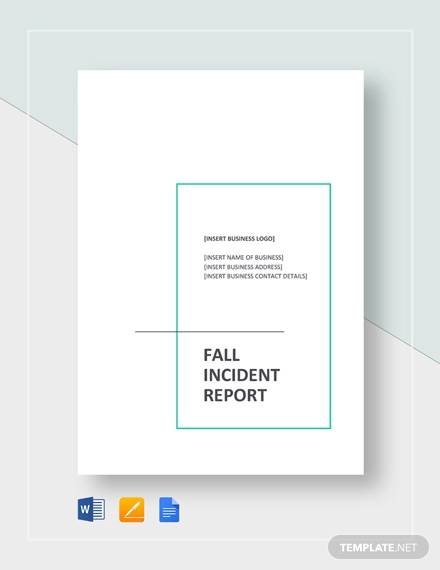
- Google Docs
Size: A4, US
General Incident Report Template
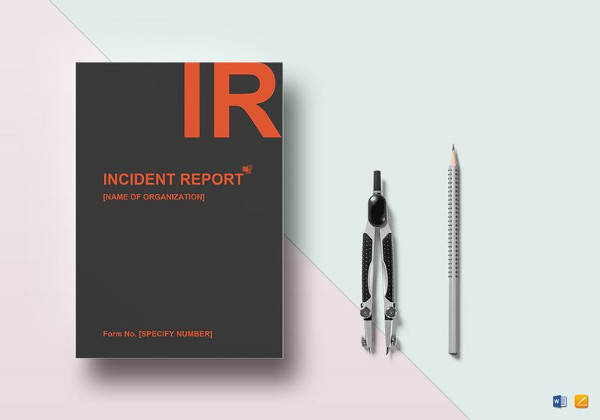
Size: US, A4
Accident Report Template

Sample Post Fall/Incident Report Template
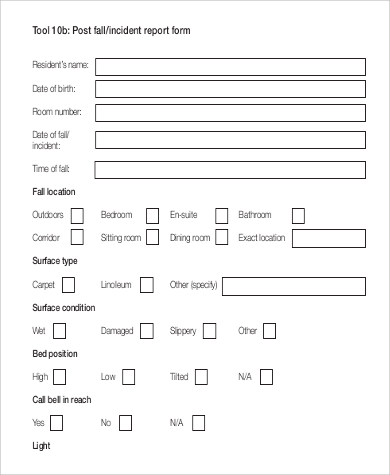
Size: 65 KB
Fall from Height Incident Report Template
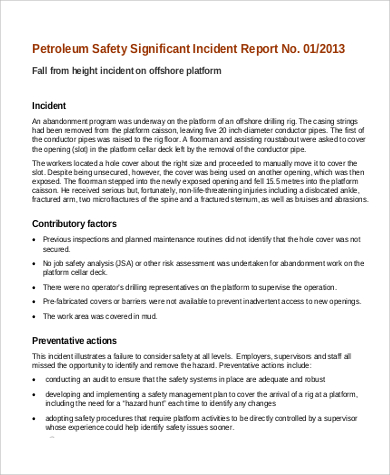
Size: 41 KB
Fall Incident Report Example

Size: 130 KB
Fall Incident Report in DOC
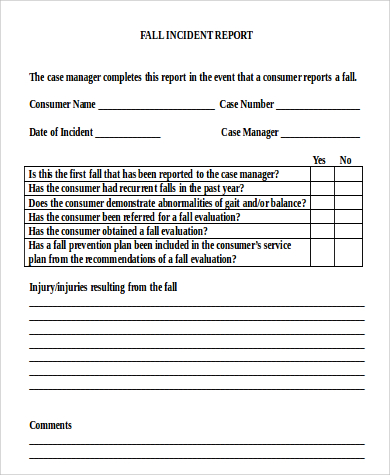
One of the most common incidents is falling. It can happen anywhere. You can trip over a flight of stairs, or perhaps miscalculated a jump, or perhaps fall off a ledge, or worse, fall from the eighth floor window. The slightest inattention to your surroundings can cause you bruises, wounds, and a few cuts or, the worst case scenario, your life. Thus, a report must be made. A form called a fall incident report is a document that formally divulges a circumstance where a person or a group of individuals fall. The steps that must be undertaken in filing for one are the following:
- First, you have to inform or notify your employer about the incident.
- You can help perform some first aid, but only if you know how to.
- File for an incident report. Your name and contact details, the nature of the injury and which body parts are affected, the name of the injured, when, where, and how the injury is acquired and your signature.
We have a wide range of Incident Report Samples, so you can just check out and download whichever suits the incident you are to disclose. But falls may not be the only incident that you have to take sample note of. Here are some of the most common incidents that may occur in the workplace:
- electrical incidents,
- injuries (neck, arm, leg),
- falling objects incidents, and
- exhaustion.
Take note that incidents can affect productivity. It is really important to file an incident report since you can alert the management on what has been going on in the field or in the office. They can then investigate or look the matter over and perhaps come up with solutions. We have free Investigation Report Samples .
Fall Incident Report Form Template
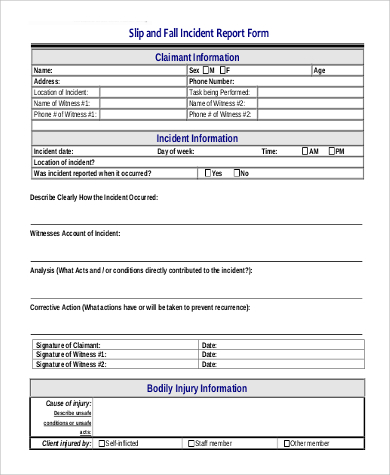
Size: 319 KB
Sample Fall Incident Report Template
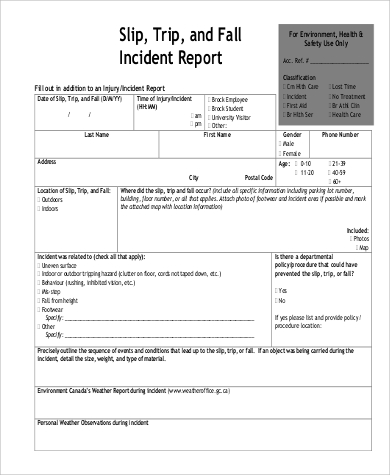
Size: 720 KB
Fall Incident Report in PDF
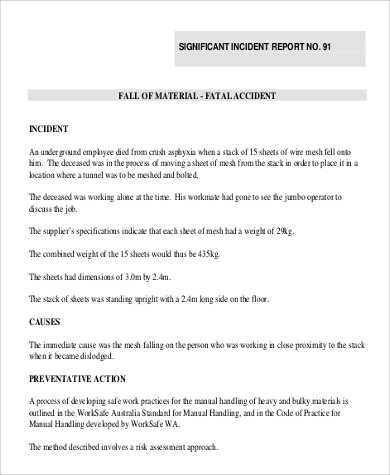
Size: 11 KB
Basic Fall Incident Report Template
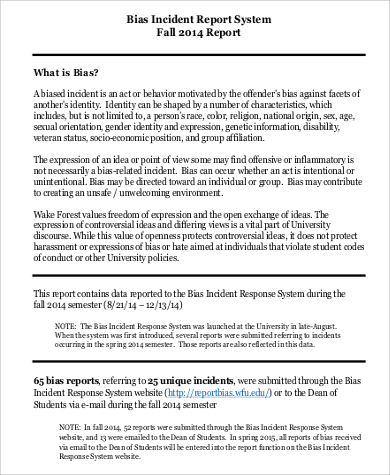
Size: 99 KB
As much as we don’t want bad things to happen, they just do. Incidents are not good, but when they happen, it provides the employers and their employees a wake-up call to be more careful and to do better at their job analysis . They also give them an opportunity to evaluate their policies and their safety measures.
A workplace is a microcosm of the society. Just like the society, unfortunate things happen to anybody and thus, pushes other people to extend their help. It is just like that at work. If somebody is suffering, other people are motivated to forget themselves for a while and think of those who need their assistance. We also have other incident forms, such as Employee Incident Reports . You can also download them for free!
Related Posts
Free 6+ teachers weekly report samples [ accomplishment, duty, work ], free 15+ sample visit reports in pdf | ms word | apple pages, free 10+ acknowledgement for internship report samples [ hotel, hospital, teaching ], free 11+ student performance report samples [ medical, academic, class ], free 15+ field report samples in pdf | ms word, free 11+ field trip report samples [ agriculture, educational, environmental ], free 49+ sample reports in ms word | pdf, free 10+ physics lab report samples in pdf | ms word, free 13+ construction inspection report samples in pdf | ms word, free 20+ annual report samples in pdf | ms word | pages | google docs | ai, free 9+ land survey report samples [ project, market, online ], free 12+ writing assessment report samples [ risk, psychological, security ], free 37+ sample hr report templates in ms word | pdf |apple pages | google docs, free 9+ child observation report samples [ school, behavior, physical ], free 10+ quality assurance report samples [ audit, monthly, investigation ], sample incident reporting form - 9+ free documents download in ..., sample trip report - 9+ documents in pdf, sample trip report - 12+ documents in word, pdf, sample incident report form - 6+ documents in pdf, word.

- Search search
- Slips Trips and Falls
- Preventing Slips Trips and Falls
Preventing Slips, Trips and Falls
Learn what you can do to prevent and control slip, trip and fall hazards in the workplace.
Page Content
Slip, trip and fall hazards, for more information.
Slips, trips and falls can happen in any workplace, and should not be overlooked. They can cause:
- Minor injuries such as sprains and strains.
- Broken bones due to the impact when trying to break the fall.
- Back injuries due to the impact from the fall.
- Cuts if the incident occurs near sharp objects.
- Head injuries if the person hits the head upon impact.
- Burns if the incident occurs near hot surfaces, or if the person is handling hot fluids.
- Death in more serious cases. For example, a person may slip and fall off an open side of a building if it is not barricaded.
The table below lists:
- Hazards associated with slips, trips and falls.
- Examples of risk control measures that your risk assessment team can take to minimise or eliminate the risks associated with these hazards.

Employer's Role
- Conduct Risk Assessments (RA) to eliminate or minimise slip, trip and fall risks.
- Maintain a safe work environment (e.g. by selecting the right type of non-slip flooring and providing sufficient illumination at the workplace).
- Provide employees with personal protective equipment (e.g. non-slip work shoes), training, instruction and supervision for relevant work activities.
To improve workplace practices, you should also:
- Establish clear standards for workplace housekeeping and set an expectation for employees to maintain them. Refer to the WSH Guidelines on Workplace Housekeeping for more information.
- Conduct routine workplace inspections to confirm that all hazards have been addressed, and to ensure that your risk control measures have been effectively implemented.
- Encourage employees to report near-miss incidents so that you can prevent future accidents.
- Encourage employees to submit ideas on slip, trip and fall prevention through a WSH staff suggestion scheme.
Employee's Role
- Adhere to safe work procedures and instructions.
- Not endanger yourself or others with unsafe behaviour (e.g. running across a wet floor or using a handphone while walking down the stairs).
- Use personal protective equipment (e.g. non-slip work shoes) provided by your company.
- Clean up all spills promptly.
- Keep walkways and staircases free of obstacles.
- Keep the floor in the work area dry, clean and free from clutter.
- Tape down power cords or cables to prevent tripping.
- Report any hazards you spot (e.g. damaged floor tiles, curled mats), and place a warning sign to alert others before the hazard is removed.
- Report all near misses and accidents promptly to your employer.
- Submit suggestions on slip, trip and fall prevention.
- ABC Checklist – Slips, Trips and Falls
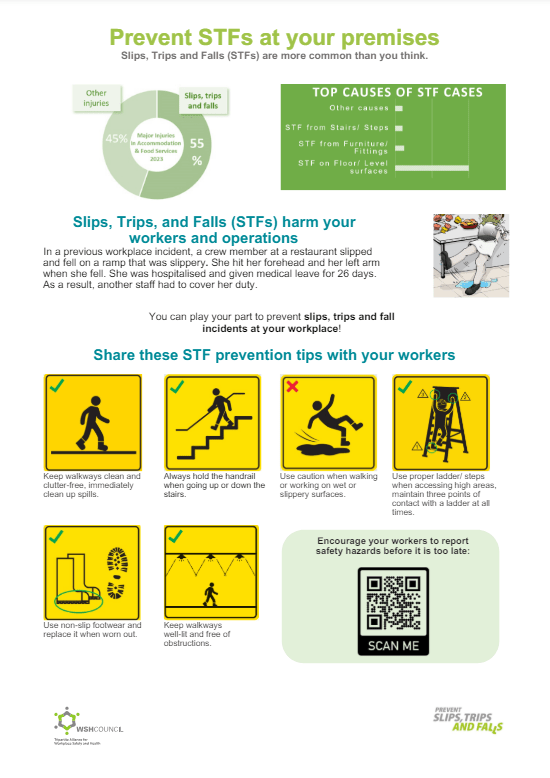
05 Jun 2024 Collaterals Posters

04 Jun 2024 Newsletters WSH Bulletins
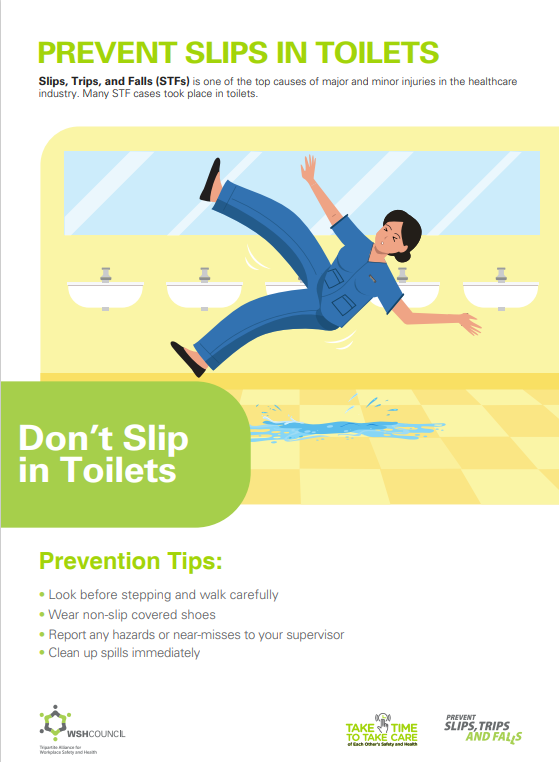
31 May 2024 Collaterals Posters
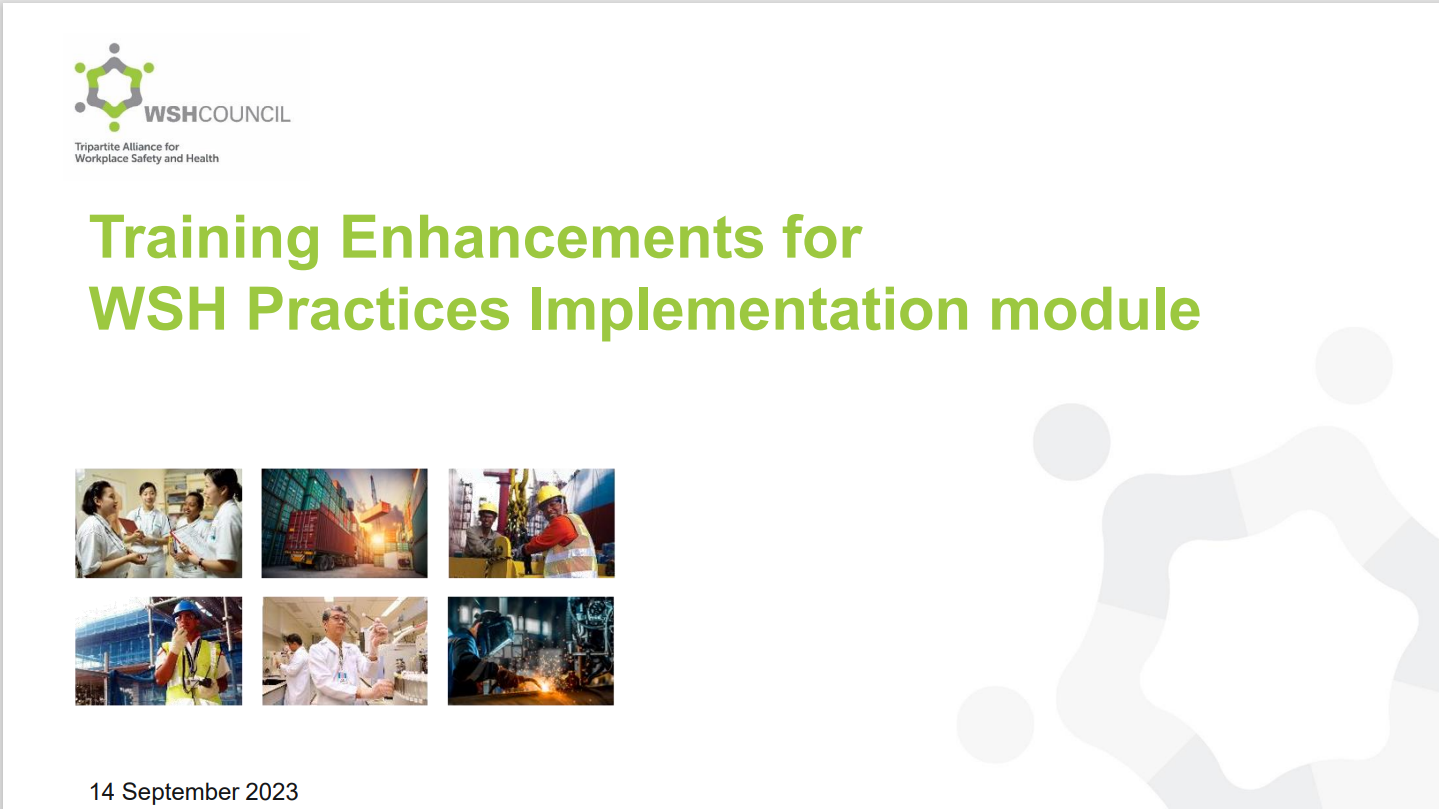
19 Apr 2024 Training Materials Resources for Training Providers
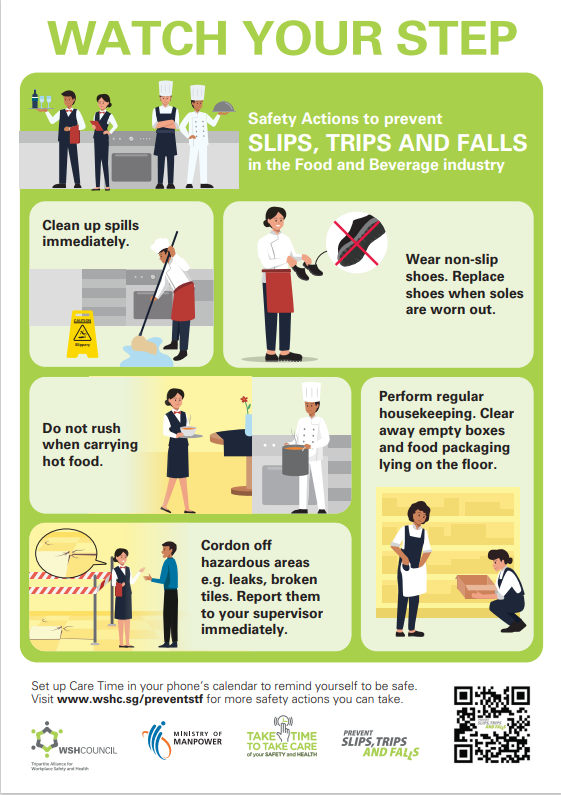
04 Oct 2023 Collaterals Posters
Advisory – Beware of scams and phishing emails
Send us feedback if you receive any suspicious or inappropriate emails asking for your personal information. The email may not have been sent by Workplace Safety and Health Council. Do not click on any link or open any attachments. Your feedback can help us fight against scammers – contact us immediately. We use cookies on wshc.sg to provide a better user experience that's more tailored to you. If you continue, you are giving us your consent to receive cookies only on this site. To decline cookies at any time, simply adjust your browser settings. Read our Privacy Statement.
How Do I File an Accident Report After a Slip and Fall Injury?
Injured in a slip and fall accident? Contact an experienced slip & fall lawyer today.
Slip and Fall Incident Report
In a car accident, you call 911, wait for the police to show up, and they will write a traffic collision report.
This does not exist for a slip, trip, or fall injury. Instead, you should look for somebody at the location, such as a supervisor, to write up an incident report.
Unlike a police report, you may write this report in its entirety or an employee will note down the fact. Even though it may not be from an unbiased source, it still makes a record of the incident.
One of the most important things is to notify the management of the location as quickly after the injury fall as possible.
In the report, you should get the following down on the report regarding the fall:
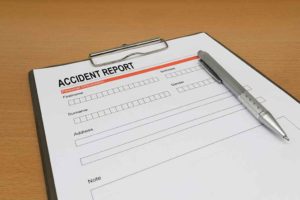
- the date of the incident;
- the time of the incident;
- the exact location of the incident;
- the mechanics of the fall (i.e. which body part slip or trip, and which body part hit the ground first, second, etc.);
- and injuries.
As with car accidents, it is a good idea to take photos of the injury scene. Snap pictures with your cell phone of the deviation or substance that caused your fall, and the surrounding area. Plus take photos of your injuries and your shoes. These helps establish a record of the incident and shows that there was an issue in the walkway.
Afterwards, you should go to the doctor to care for your injuries and prevent them from getting worse.
Additionally, you’ll want to discuss the incident with a personal injury attorney , especially if your injuries are severe. If the attorney takes your case, they will send an investigator to inspect the scene, take photos, measurements, and gather evidence as necessary.
Call Michael Beliz today at 562-452-3772 if you need to discuss a recent injury.
We’re getting your search results.
- Customer support
- Customer login
- Report a claim
- Find an agent
- Roadside assistance
- Manage policy
- Hanover Mobile
- Choose paperless
- Education and training
- The Hanover Risk Solutions
- COVID-19 information center
- Preparation and prevention
- Coverage made clear
- Claims made clear
- Media contacts
- Login to TAP
- Personal lines
- Commercial lines
- Resource library
- Become an agent
- Investors overview
- Statutory results
- Annual reports
- Event calendar
- Historical prices
- Presentations
- Press releases
- Quarterly results
- Stock quote
- ESG overview
- Inclusion and diversity
- Sustainability report
- Early in career opportunities
- Forgot username
- Forgot password
- Create an account
- Report a claim without logging in
- Individuals
- About The Hanover
- I'm looking to...
- Adding a new driver
- Buying a first motorcycle
- Moving out and moving up
- Ready for retirement
- Updating your home
- Buying a boat
- Buying a home
- Buying or selling a car
- Getting married
- Starting a family
- Recreational vehicles
- Condominium
- Home business
- Valuable items
- Hanover Platinum
- Hanover Prestige
- Get a quote from a local agent
- Manage my policy
- Manage my account
- Partners in Protection
- Water damage prevention
- Construction
- Cultural institutions
- Educational institutions
- Financial institutions
- Human services
- Life sciences
- Manufacturers
- Professional services
- Real estate
- Wholesalers
- Business owner's policy
- General liability
- International
- Management liability
- Professional liability
- Workers' compensation
- Customer onboarding
- Sickness prevention center
- About Hanover claims
- Claims resources and FAQs
- Reviews and testimonials
- Workers' compensation claims resources
- What to expect with your claim
- Prepare now. Learn how.
- Weather resource center
- Our companies
- Our history
- Our leadership
- Board of directors
- Our governance
- Our locations
- Sustainability
- Inclusion, diversity and equity
- Recognitions and awards
- Global reporting initiative index
- Community impact
- News releases
- In the media
- Find out what coverage I need
- Explore insurance products
- Save with bundled coverages
- Contact an agent for a quote
- Learn about The Hanover
- Find out what coverage my business needs
- Pay my bill
- File a claim
- Talk to an agent
- Get roadside assistance
- Sign up for paperless
- Set up Hanover mobile
- Print ID card
- Get tips on preparedness
- Agent Solutions
- Discover employee benefits
- Look for a job
- See our locations
Sample slip, trip and fall prevention program
This sample program is intended to provide general information to consider in developing a slip, trip and fall prevention program. This sample program may or may not represent all components of a slip, trip and fall safety program needed by your unique operations or comply with all legal requirements and/or standards. You are responsible for tailoring the program to address the specific needs of your organization.
Table of Contents
- Introduction
- Sample policy statement
- Housekeeping standards
- Seasonal issues
- Corrective maintenance procedure
- Workplace inspection policy and procedure
- Responsibilities
- Safety rules
- Accident investigation procedure
- Additional tools and resources
- Appendix A periodic inspection report Appendix B sweeping log
- Appendix C walking and working surfaces — self inspection checklist Appendix D accident investigation report
- Appendix E snow and ice control record
1. Introduction
Nationally, falls are the second leading cause of accidental death and a major cause of debilitating injuries. This program is designed to reduce exposure to both visitor and employee slip, trip and fall accidents.
2. Sample policy statement
The most effective safety program policy statements reflect your unique operations and environment. Here is a sample:
“It is the policy of ABC, Inc. to provide our employees and customers safe and healthful conditions in which they can conduct business. We will strive to maintain a facility that is free from identified slip, trip and fall hazards. We have implemented a prevention program that considers the behaviors of people, our equipment, our work methods, processes and finally the environment to reduce and prevent slip, trip and fall accidents. We expect all employees to cooperate in this very important initiative to ensure its success.”
3. Training
Management believes that employee involvement in the site’s safety and health program can only be successful when everyone on the site receives sufficient training to understand what their safety responsibilities and opportunities are, and how to fulfill them. Therefore, training is a high priority to help ensure a safe workplace.
All employees will receive awareness training during orientation. Employees who conduct formal workplace inspections will be trained on their responsibilities and on how to perform them.
4. Housekeeping standards
Housekeeping plays such a critical role in the success of our slip, trip and fall prevention program that all employees must make housekeeping their top priority. The following are minimum accepted guidelines:
- Work areas are to be kept clean throughout your shift and a thorough review and cleaning must be completed prior to leaving your shift.
- Walkways will be kept clear of electric cords, hoses or any other potential hazards. If walkways cannot be kept clear then they need to be blocked off until the task is completed.
- Spill areas must be secured until the spill is removed.
- Stock or finished goods will not be stored on stairs, in walkways or in such a manner that would be a hazard to anyone walking through.
5. Seasonal issues
The changing seasons create unique weather-related conditions for which the following procedures have been developed:
- All building entrances will be cleaned of snow and ice, and will be treated with salt, one hour prior to the opening of business.
- Exterior walkways will be inspected hourly and treated as needed.
- Use the form “Snow and Ice Control Record” found in Appendix E to document the work.
- Parking lots will be inspected daily. Any snow or ice that has accumulated between cars will need to be removed.
- During the fall, daily inspections will be made and action taken as needed to ensure walkways are cleared of leaves.
6. Corrective maintenance procedure
When a hazard has been identified through inspection or our hazard reporting program, maintenance must be notified so that the problem can be corrected. The following is the procedure to accomplish this task:
- Any problem needs to be communicated to the manager immediately.
- The maintenance manager will inspect the problem and communicate the best action to take.
- If it can’t be corrected immediately, a temporary control will be put in place to prevent anyone from being injured.
7. Workplace inspection policy and procedure
Our goal is to ensure a safe, clean and hazard free environment for employees and customers. Workplace inspections will be conducted to identify and correct potential safety and health hazards.
Use our “Walking and Working Surfaces — Self Inspection Checklist” found in Appendix C to document the inspection.
- Inspections will be carried out by supervisors of their functional areas. The manager will inspect common areas and all outside areas including the parking lot.
- Any deficiencies or hazards must be acted upon to remove the hazard, warn of it or close off the area in question.
Three types of inspections are used to assess our facility. Each type of inspection has its own purpose.
Annual inspections
Once a year an inspection team made up of representatives of the organization will do a wall-to-wall walk through inspection of the entire worksite. They will use the “Walking and Working Surfaces — Self Inspection Checklist” found in Appendix C. The results of this inspection will be used to:
- Eliminate or control obvious hazards.
- Target specific work areas for more intensive investigation.
- Assist in revising the checklists used during periodic safety inspections.
- Evaluate the effectiveness of our slip, trip and fall prevention program.
Change of operations surveys
Changes include new equipment, changes to production processes or a change to the building structure or premises. Examine the changed conditions and make recommendations to eliminate or control any hazards that were or may be created as a result of the change. This needs to be comple ted during the design stage of any proposed changes to ensure recommendations are incorporated into the changes. The “Walking and Working Surfaces— Self Inspection Checklist” found in Appendix C can be used as a guide for this survey.
Periodic safety inspections
Supervisors or their appointees will inspect their work areas for hazards using the “Walking Surfaces Periodic Inspection Checklist.” The results of the periodic inspection and any action taken will be documented.
8. Responsibilities
It’s important that all employees understand their responsibilities. The following are some examples that can be tailored to fit your organization’s management structure.
Management responsibilities
- Ensure that sufficient employee time, supervisor support and funds are budgeted for safety equipment, training and to carry out the safety program.
- Evaluate supervisors each year to make sure they are carrying out their responsibilities as described in this program.
- Ensure that incidents are fully investigated and corrective action taken to prevent the hazardous conditions from developing again.
- Set a good example by following established safety rules and attending required training.
Supervisor responsibilities
- Supervisors must assure this program is adhered to and that all employees follow program policies and procedures.
- Ensure that each employee you supervise has received an initial orientation before beginning work.
- Observe the employees as they work. Promptly correct any unsafe behavior.
- Do a daily walk-around safety-check of the work area and promptly correct any hazards you find.
- Set a good example for employees by following safety rules and attending required training.
- Investigate all incidents in your area and report your findings to management.
- Talk to management about changes to work practices or equipment that will improve employee safety.
Employee Responsibilities
- Clean up spills and pick up debris to help ensure others are not injured on company property
- Report hazards to supervisors or managers promptly for corrective action.
- Follow safety rules, safety standards and training you receive as described in this program
- Report all injuries and near miss incidents to your supervisor promptly regardless of how serious.
- Make suggestions to your supervisor or management about changes you believe will improve employee safety.
Maintenance/engineering
- Must purchase waxes with non-skid characteristic and do not decrease the coefficient of friction of floor surfaces.
- Review floor cleaner data sheets to assure that no slippery floors are created.
- Must integrate the stair design requirements, uniformity of risers, and tread principles, ramp requirements and slope considerations into building design, and building modifications as appropriate.
Facility safety
- Will inspect buildings for hazards and inform maintenance and/or housekeeping of hazards that are identified.
- Will supply deicer in buckets along with scoops at building entrances during inclement weather.
- Check floor surfaces as requested for slip or trip hazards, determine any needed corrective action and notify appropriate party to correct the problem.
Housekeeping
- Must use barricades when the floor they are working on is slippery or presents a tripping hazard. Barricades will be removed as soon as the hazard is corrected.
- Place non-skid mats at building entrances during inclement weather. Inspect mats periodically or as needed to ensure they are properly controlling the hazard.
9. Safety rules
The following basic safety rules have been established to control slip, trip and fall accidents. These rules are in addition to safety rules that must be followed when doing particular jobs or operating certain equipment. Failure to comply with these rules will result in disciplinary action.
- Always take the proper safety precautions before doing a job. If a job is unsafe, report it to your supervisor. We will find a safer way to do that job.
- Horseplay, running and fighting are prohibited.
- Clean up spills immediately. Replace all tools and supplies after use.
- Keep tools or materials out of designated walkways.
- Protect all spill areas. If needed, get someone to help clean up the spill or guard the spill while you get the necessary equipment to clean the spill.
- If you see a slip or trip hazard do something about it. It’s the responsibility of everyone to identify and control hazards.
- Make sure scraps don’t accumulate where they will become a hazard. Good housekeeping helps prevent injuries.
Proper footwear is an important component of our slip, trip and fall prevention program. Footwear needs to be appropriate for the task. In many of the work areas other than our offices, high heeled shoes and leather soled shoes are considered unsafe and must be avoided. It is the responsibility of each employee to obtain and maintain slip resistant footwear in a serviceable condition. Supervisors will ensure that employees are wearing appropriate slip resistant footwear at all times in the workplace.
Mats and Runners
Our goal is to maintain all floor surfaces in a slip resistant condition. In those work areas or situations where this isn’t feasible, mats or runners will be used to provide slip resistance. It is everyone’s responsibility to monitor mats and runners to ensure they continue to provide proper slip resistance and have not become a tripping hazard.
Where mats have been used to control wet areas, either entry ways to the building or wet processes, the following conditions require immediate action:
- If pedestrian traffic leaves wet foot prints when stepping off the mat, the mat needs to be replaced with a dry one or an additional mat needs to be placed at the end of the first mat.
- If the mat has become wrinkled or bunched up it needs to be reset so it is flat and doesn’t present a tripping hazard.
10. Accident investigation procedure
All accidents will be investigated and analyzed to identify the root cause. The following steps will be taken when an accident occurs.
- Helping the injured person will be the primary concern immediately following an accident. Never leave the person alone. If assistance is needed send someone else or have someone stay with the person while you get help.
- If the injured party is not an employee, do not admit liability or fault for the accident. If they ask if we are going to pay for their medical costs simply state that someone from The Hanover Insurance Group will be in touch with them.
- Protect the accident scene to prevent anyone else from getting hurt and to preserve the accident scene in an “as is” condition to help ensure an accurate investigation.
- Contact the supervisor of the area where the accident occurred so they can begin the collection of data and accident analysis.
- The information will be collected and the analysis completed using our “Accident Investigation Report.”
- Photos need to be taken of the general area, any defective conditions and anything else that could be considered as a contributing factor of the accident.
- Once the root cause is determined, corrective action will be initiated immediately following standard procedure.
11. Additional tools and resources
The following resources are available to help in the development of your slip, trip and fall prevention program. They can be found on www.hanoverrisksolutions.com .
Loss Control Topics
- Preventing Restaurant Employee Slips and Falls
- Sidewalk Inspection Checklist
- Parking Lot Safety
- CPSC Tips for Public Playground Safety
- Fall Prevention Checklist
- NIOSH Slip, trip and fall prevention in the healthcare industry
To learn more about Hanover Risk Solutions, visit hanoverrisksolutions.com
171-0954 (3/16) LC 11-187
12. Periodic inspection report
Modify this form to meet the unique characteristics of your facility. The items listed are a guide and may not include all your possible hazards.
171-0954 (3/14) LC 11-187
Sweeping log
An entry is to be made on this log every time the floor is swept or is observed to be free of foreign material. Sign you name and indicate the time of the observation or cleaning.
171-0954 (3/14) LC 11-187
13. Walking and working surfaces — self-inspection checklist
Slips, trips, and falls constitute the majority of general industry accidents. The Occupational Safety and Health Administration’s (OSHA) standards for walking and working surfaces apply to all permanent places of employment, except where only domestic, mining, or agricultural work is performed. This “self-inspection” checklist, developed from OSHA guidance, can be used by supervisors to create a safer work environment.
171-1083 (02/14) LC 10-265 H June 2010
Sample accident investigation form
Accident information.
Date of accident: __________________________________ Date of report: _______________________________________
Where did the accident occur? ___________________________________________________________________________
Time of accident: __________________
Name(s) of injured: ____________________________________________________________________________________
Are these company employee(s)?
Contractors?
Names of non-company individuals (if applicable): ____________________________________________________________
____________________________________________________________________________________________________
Occupation of employee(s): _____________________________________________________________________________
Witnesses to accident: _________________________________________________________________________________
Description of any property damage: ______________________________________________________________________
___________________________________________________________________________________________________
Description of events: __________________________________________________________________________________
Contributing factors
Act(s) (describe): ______________________________________________________________________________________
Conditions (describe): __________________________________________________________________________________
Root cause(s) of accident: _______________________________________________________________________________
Corrective actions to take
(Describe what actions need to be taken to prevent a reoccurrence)
Report developed by:____________________________________Dept.: ____________________________________
Report reviewed by:_____________________________________ Date:_____________________________________
171-0830 (1/14) LC 12‐169
14. Snow and ice control record
PAGE __________
Instructions: Use this log to document efforts to maintain walking and driving surfaces during winter weather. Keeping completed records may improve your defense position in the event of an incident.
This material is provided for informational purposes only and does not provide any coverage or guarantee loss prevention. The examples in this material are provided as hypothetical and for illustration purposes only. The Hanover Insurance Company and its affiliates and subsidiaries (“The Hanover”) specifically disclaim any warranty or representation that acceptance of any recommendations contained herein will make any premises, or operation safe or in compliance with any law or regulation. By providing this information to you, The Hanover does not assume (and specifically disclaims) any duty, undertaking or responsibility to you. The decision to accept or implement any recommendation(s) or advice contained in this material must be made by you.
171-0878 (1/15) LC 09-444 H

- Certification Overview
- Master Safety Professional (MSP)®
- Certified Safety Director (CSD)®
- Certification Prep Courses
- Recertification Overview
- Safety Professional Certificate (SPC)
- Safety Director Certificate (SDC)
- Certified Safety Manager (CSM)
- Certified Safety Manager: Construction (CSMC)
- Certified Safety Manager: Healthcare (CSMH)
- Certified Environmental Manager (CEM)
- ADA Compliance Certificate
- Environmental Health and Safety Professional Certificate (EHS)
- Safety Auditor Certificate (SAC)
- Human and Organizational Performance (HOP)
- HAZWOPER Train-the-Trainer (HTTT)
- Hydrogen Sulfide Safety (HST): Train-The-Trainer
- Aerial And Scissor Lift (ASLS)
- Basic Principles in Occupational Hygiene
- Behavior Based Safety (BBS)
- Bloodborne Pathogens And First Aid Treatment (BPS)
- Confined Space Entry – Construction (CSSC)
- Confined Space Entry (CSS)
- Crane Derrick Safety (CDS)
- DOT Hazmat (DHS)
- Electrical Safety (ESS)
- Emergency Management (SEM)
- Environmental (ENS)
- Fire Prevention (FPS)
- Forklift Safety (FSS)
- Hand And Power Tools (HPS)
- Hazard Communication (HCS)
- Hazardous Waste Management (HMS)
- HAZWOPER (HZS)
- Incident Investigation (IIS)
- Job Hazard Analysis (JHA)
- Lockout Tagout (LTS)
- Machine Guarding (MGS)
- OSHA Recordkeeping (ORS)
- Personal Protective Equipment (PES)
- Scaffold Safety (SSS)
- Silica Dust (SDS)
- Spill Containment (SCS)
- Training Methodology Specialist (TMS)
- Steel Erection (SES)
- Trenching And Excavation (TES)
- Walking-Working Surfaces And Fall Protection (WWS)
- Welding Cutting Brazing (WCB)
- Workplace Ergonomics (WES)
- Workplace Violence Prevention (VPS)
- 10- and 30-hour Courses
- General Industry
- Construction Industry
- Environmental Industry
- Oil & Gas Industry
- Courses Overview
- Full Course Catalog
- Live Courses
- On-Site Training & Consulting
- Franchises and Partnerships
- Trainer Resources
- Certificate Directory
- Financial Aid
- Veteran Benefits
- Testimonials
- NASP Videos
- Recertification
- NASP Merchandise Shop
- Regulatory Agencies
- Client/Member Login
How to Prevent Falls, Trips, and Slips on the Job Site
A workplace slip and fall can result in serious injury, so prioritizing preventative measures is essential. When you implement effective safety plans, train employees, enforce policies, and maintain walking and working surfaces, you can prevent or reduce workplace accidents. Creating a safer work environment and building a safety culture in your company are the best ways to protect your employees in any work environment.
Importance of Slip, Trip, and Fall Safety
Slips, trips, and fall prevention is essential on any job site, but it’s especially crucial in industries that involve heavy machinery, high shelving, or a high likelihood of wet floors. Focusing on fall safety offers the following benefits:
Employee Safety, Morale, and Retention
Prioritizing employee safety helps protect individuals from harm and can boost morale. The more measures you take to protect your employees, the more likely your employees are to trust you and want to stay with the company.
Cost Savings
Implementing an effective safety plan that prevents falls can help your company save money. Most companies must pay workers’ compensation if an employee is injured on the job. While this protects companies from direct lawsuits, it can also result in high costs as employers cover medical coverage for injured employees. In 2022, workplace injuries cost companies a total of $167 billion . Taking steps to prevent falls may help your company reduce workers’ compensation claims and save money.
Productivity and Efficiency
Preventing slips, trips, and falls can also boost your company’s productivity and efficiency. When fewer employees experience accidents and injuries, you have more individuals able to work. A fall can result in a serious injury depending on how a person falls and what part of their body they land on, and this can potentially cause a worker to be in the hospital or at home for a prolonged time.
Preventing falls can help you keep more employees safe, at work, and able to produce quality results, helping you meet productivity and efficiency goals.
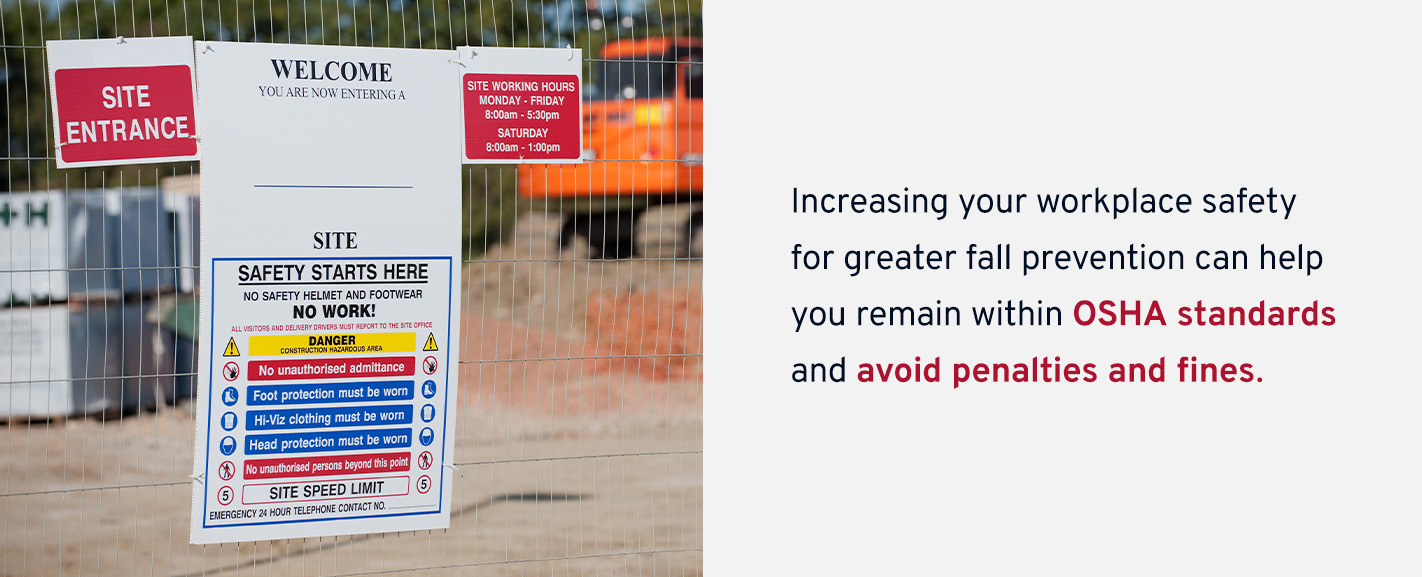
The Occupational Safety and Health Administration (OSHA) enforces regulations regarding walking and working surfaces . Increasing your workplace safety for greater fall prevention can help you remain within OSHA standards and avoid penalties and fines.
Primary Causes of Slips, Trips, and Falls in Work Settings
To fully understand how to prevent slips, trips, and falls on the job site, you must first understand what causes them. Consider how each of the following accidents can occur:
Trips occur when individuals lose balance due to their foot hitting or striking an object. An employee may trip due to one of the following factors:
- Clutter or obstructions such as power cords, hoses, boxes, or tools on the floor or ground
- Inadequate lighting
- Irregular or uneven walking surfaces
- Curled-up or wrinkled rugs
- Rugs with lifted edges
- Inattention to surroundings
- Running or walking too fast
Tripping occurs when an employee moves with enough momentum to lose balance. Paying attention to their surroundings and walking at a slow pace are the most important ways to prevent trips.
Slips occur due to a lack of traction or friction between walking surfaces and footwear. The following factors can cause an employee to slip while working:
- Oily or wet surfaces
- Liquid spills
- Dry products such as dust or powder on the floor
- Weather hazards such as rain puddles, snow, or ice
- Loose mats or rugs
- Greasy, muddy, or wet shoes
Slips and trips are common causes of falls, but the following factors can also cause an employee to lose balance and fall:
- Obstructed views from walking while carrying large objects or turning a corner too fast
- The use of inappropriate equipment such as tables, chairs, or carts to reach high areas
- Using ladders or other equipment incorrectly
- Elevated platforms or surfaces lacking guardrails
How to Avoid Slips, Trips, and Falls in the Workplace
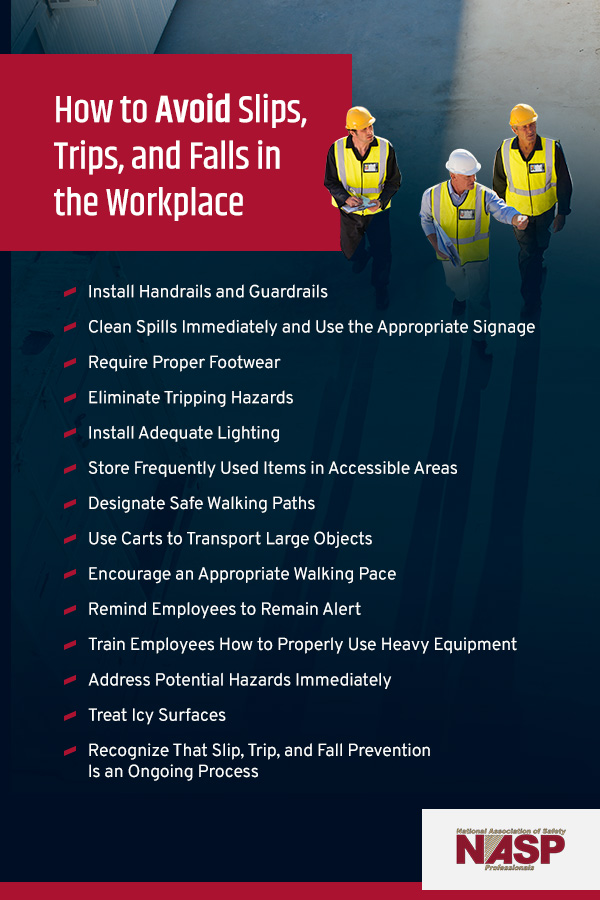
You can help employees avoid or reduce slips, trips, and falls with the following tips and safety precautions:
Install Handrails and Guardrails
Handrails provide support for employees walking up or down a staircase. Ensure each set of stairs inside and outside your building has handrails so employees and patrons can remain steady while walking.
Guardrail installation is also essential. If your facility contains any type of elevated platform or surface, you must install guardrails to prevent employees from falling.
Clean Spills Immediately and Use the Appropriate Signage
Spills present a significant slipping hazard, so you should clean them immediately after they occur. Remind employees to avoid leaving spills unattended and instead ask a colleague to gather cleaning supplies. It’s also important to place “wet floor” signs in the affected area until the floor is completely clean and dry, and this applies to any time you mop the floor. These actions prevent employees from walking through the spill unknowingly.
Signage is also helpful when your facility has freshly waxed floors. Waxing a floor makes its surface slippery, so it’s important to let employees know when they should walk with extra caution.
Require Proper Footwear
Proper footwear provides the traction employees need to walk on wet and slippery surfaces safely. Most companies aiming to prevent falls require individuals to wear skid-resistant shoes with soft rubber soles because they grip wet surfaces better than other types of shoes. The right shoes can significantly increase an employee’s likelihood of avoiding slips in the workplace.
Help employees obtain proper footwear by recommending quality brands and where to purchase them. You can also let your employees know if your company offers financial support for shoe purchases through reimbursement programs. Another way to ensure employees wear proper footwear is to work it into your employee handbook and enforce it as a safety policy.
Eliminate Tripping Hazards
The more tripping hazards you remove from a work area, the easier it is to prevent falls. Frequently remind employees to keep walkways, stairways, and doors free of objects. This may mean keeping tools up and off of the floor or ensuring extension cords are out of the way. If you must run an extension cord across a walkway, secure it in place with brightly colored tape so employees can see it easily.
Another tripping hazard is open cabinet doors and desk drawers. Remind employees to keep these storage spaces closed when they are not in use to prevent individuals from walking into them and tripping.
Install Adequate Lighting
Well-lit areas help employees see potential tripping hazards and slippery surfaces easier than they would in dimly lit areas. Ensure each area in your facility has adequate lighting to increase visibility and replace lightbulbs when necessary. The best way to increase visibility is to install motion-sensor lights because they provide adequate lighting while conserving energy.
Store Frequently Used Items in Accessible Areas
Making items easily accessible can help reduce foot traffic and accidents in your facility. For example, placing the right cooking tools directly in a chef’s workstation reduces the amount of time they need to walk across the kitchen. Similarly, storing materials in an easily accessible area within a warehouse reduces the number of times employees need to reach for items on high shelves.
Designate Safe Walking Paths
Designating safe walking paths and clearly marking them can help employees avoid hazardous areas. This is especially true in warehouses where many areas are prone to tripping hazards. Place yellow tape on the floor to mark safe walking paths, and remind workers to keep these paths clear of objects such as tools and cords.
Use Carts to Transport Large Objects
Walking with or pushing large objects across a room can cause an employee to collide with another person or trip over an obstacle. Provide employees with carts they can use to transport large items through your building or across a job site.
Encourage an Appropriate Walking Pace
Walking at a slow pace helps people avoid trips, slips, and falls because it gives them more time to notice obstacles or catch their balance. Create a “no running” policy for employees and encourage everyone to move at a slow pace.
Remind Employees to Remain Alert
Alertness and awareness are essential for preventing falls and accidents. In your safety training, remind employees to remain aware of their surroundings by avoiding reading, texting, or scrolling while walking.
Train Employees How to Properly Use Heavy Equipment
Part of using heavy equipment safely is proper entrance and exit. Train employees how to get into and out of heavy machines such as forklifts to reduce the chances of them falling from the equipment.
Address Potential Hazards Immediately
As a safety professional, you are responsible for monitoring your company’s facility, employees, and operations. It’s your job to recognize potential hazards and address them as soon as possible.
Treat Icy Surfaces
If your company is in a cold climate, snow and ice are possibilities. Ensure the walkways into your facility are clear by applying ice melt each time winter weather hits. Ice melt prevents wet surfaces from freezing , and it can dissolve icy surfaces. This makes it easier and safer for employees to enter and leave the building without slipping.
Recognize That Slip, Trip, and Fall Prevention Is an Ongoing Process
The circumstances that cause falls in the workplace can be changeable and spontaneous, so it’s essential to remember that prevention is an ongoing process. You must check surfaces frequently, address hazards promptly, and ensure employees understand how to recognize hazards and avoid them.
Regulations Regarding Walking and Working Surfaces
OSHA standard 1910.22 outlines regulations companies must follow regarding walking and working surfaces. Following these regulations helps you remain compliant and can make it easier to prevent slips, trips, and falls:
Surface Conditions
All walking and working surfaces must be clean and sanitary. When compliance safety and health officers perform inspections, they check service rooms, storerooms, and passageways to determine if surfaces are clean and orderly. Additionally, floors must be clean, dry, and free of the following hazards:
- Protruding or sharp objects
- Loose boards
- Grease buildup
- Ice and snow
If your company uses wet processes, you must have a proper drainage system in place and maintain it regularly. OSHA also requires companies that use wet processes to provide dry standing places, such as platforms, mats, and false floors.
Floor Loads
OSHA requires companies to ensure their walking and working surfaces are able to support their intended loads. For example, employees must limit heavy machinery use to floors that can handle the equipment’s weight. This prevents machinery from causing accidents or damaging floors and creating tripping hazards.
Access and Egress
Safely walking to and from walking and working surfaces helps prevent falls. To comply with OSHA standards, your company must provide safe ways for employees to safely access and egress walking surfaces, and you must enforce safety policies to ensure employees use the provided means. For example, you may install ramps or platforms to access walkways, or you may place tape on the ground to indicate safe walking paths.
Maintenance, Inspection, and Repair
OSHA also requires companies to regularly inspect and maintain walking and working surfaces, completing repairs as necessary. If damage or wear occurs on one of your company’s floors, you must repair it before employees use the floor again.
If you cannot make immediate repairs, OSHA requires you to guard the hazard and redirect employees to use alternative safe walking paths. Additionally, you must hire a qualified professional to perform or supervise repairs if they involve the walking surface’s structural integrity.
How to Train Employees on Preventing Slips, Trips, and Falls
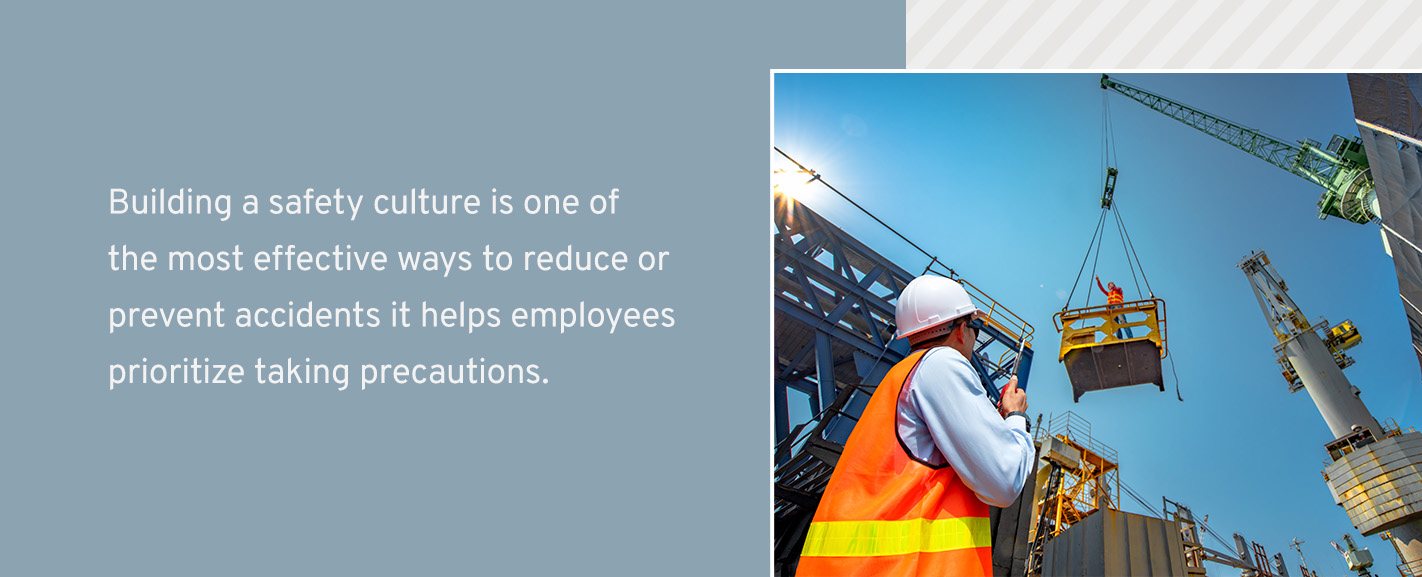
Building a safety culture is one of the most effective ways to reduce or prevent accidents because it helps employees prioritize taking precautions. While there is no required training for fall prevention, you can provide helpful information and help employees avoid unsafe situations and conditions. Use the following tips to help your employees implement safer walking practices:
- Discuss injuries: Explain to your employees that slips, trips, and falls can lead to significant injuries such as broken bones, fractures, concussions, neck injuries, deep bruising, cuts, spinal cord injuries, and fatalities. Individuals are more likely to take fall prevention seriously when they are aware of potential consequences.
- Review OSHA Standard 1910.22: Reviewing OSHA standards with employees can help them understand how policies and procedures protect them from potential injuries. Use this opportunity to explain to workers what their roles are in preventing accidents.
- Review safety precautions: Review additional ways employees can protect themselves such as walking at slow paces, wearing the proper footwear, and remaining alert.
- Point out hazardous areas: Give new employees a tour, and show them areas in your facility that may present additional fall risks. These areas may include rooms with frequent spills, such as kitchens, or heavy-traffic areas, such as warehouses.
Increase Your Company’s Safety With Training From The National Association of Safety Professionals (NASP)
Preventing slips, trips, and falls is an ongoing process that requires a safety mindset. The National Association of Safety Professionals offers a practical approach to workplace safety, providing in-depth training programs. Our certificate courses provide the information and knowledge safety professionals need to implement successful safety plans, address potential hazards, reduce workplace accidents, and comply with OSHA standards.
At NASP, we design courses to increase student retention and keep safety at the forefront of everyone’s mind. Our goal is to help your company build a safety culture that extends beyond meeting regulations, and we are dedicated to helping safety professionals expand their expertise. Browse our online professional courses and live safety training classes , or contact us to learn more about how we can help you enhance your company’s safety.
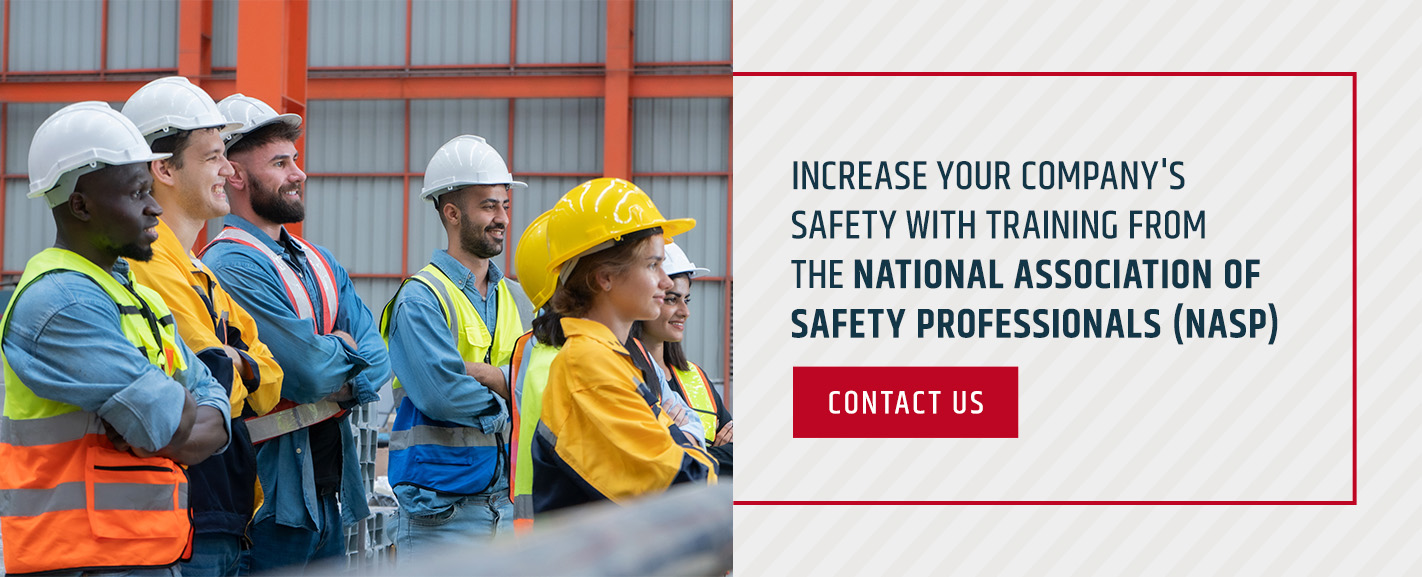
About the Author

Eric Gislason
Related posts.

Guide to Environment, Health, and Safety

What Is Human and Organizational Performance?

Emergency Preparedness in Construction : Developing a Robust Response Plan
Home » Blog » How to Prevent Falls, Trips, and Slips on the Job Site
- Free Consultation: (716) 839-3939 Tap To Call Tap To Text

10 Things To Do After A Slip-And-Fall Accident
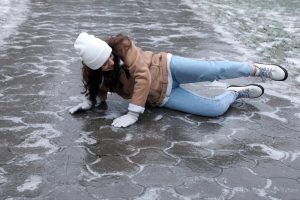
Here are 10 tips to improve your chances of success:
- Make a Doctor’s Appointment
You should always see the doctor after a slip-and-fall accident .
Even if you don’t think you’ve been seriously hurt, some common slip-and-fall accident-related injuries don’t present any immediate symptoms—meaning that the only way to obtain an accurate diagnosis is by seeing the doctor, sharing your concerns, and seeking further treatment if and when the need arises.
- Collect and Protect Your Evidence
You might not have had time to collect evidence after being injured, but you should make a concerted effort to protect your documentation.
Relevant evidence in a slip-and-fall claim could include:
- Pictures of the dangerous condition that caused your accident;
- Photographs of your visible injuries; and
- Screenshots of a conversation with a property manager, landlord, or manager.
- Speak to Eyewitnesses
If a friend, family member, or stranger saw your slip-and-fall accident, ask them for their contact information—their testimony could help you obtain compensation for your injuries.
- Submit a Formal Complaint
Contact the property owner where your accident occurred, inform them you were injured on their premises, and ask how to file an official injury report. Provide detailed and concise answers, and do not include any inaccurate or misleading information.
- Document Your Symptoms
You may find that your injuries affect your physical well-being and mental health in ways that are difficult to describe. Even if you can’t put all of your feelings into words, try to keep a journal, taking special care to detail how your injuries have impacted your overall quality of life.
- Preserve Your Records
If you take your slip-and-fall accident claim to court, you’ll need to calculate your existing and anticipated damages. Keep track of all records you have relating to your accident-related losses, including, but not limited to, the following:
- Hospital bills;
- In-home disability modifications;
- Specialist referrals;
- Exhausted PTO and vacation time; and
- Transportation expenses.
- Stay Skeptical of Insurance Adjusters
A negligent property owner may have caused your injuries, but there’s a good chance that any compensation you receive will come from an insurance company. However, before agreeing to pay a claim, insurance companies sometimes do more than their due diligence.
An adjuster could try to attack your rights to a fair recovery by:
- Insisting that you provide a recorded statement, and then use your words against you;
- Asking for access to your medical records, and then blaming an accident-related injury on a pre-existing condition; or
- Refusing to negotiate in good faith, hoping that you’ll give up and go away or accept a much lower offer of settlement.
- Don’t Rush into a Settlement…
Early offers of settlement very often exclude certain damages and are intended to resolve claims as quickly as possible and with minimal loss to the insurance company.
- … But Don’t Wait Too Long to Take Action
New York, like every state, has statutes of limitations applicable to almost all personal injury claims. If you wait too long to contact a slip-and-fall accident lawyer, the statute of limitations could lapse, and you could lose all of your rights to recovery.
- Schedule a Consultation with a Slip-and-Fall Accident Attorney
Don’t take your chances with your physical health and financial well-being: call the Dietrich Law Firm P.C. at 1-866-529-5334, or send us a message online to schedule your 100% free, no-obligation consultation as soon as possible.

Common Triggers of Slips, Trips, and Falls – And How To Avoid Them
Slips, trips, and falls are some of the most common causes of workplace injuries in the US, accounting for over 8 million emergency room treatments every year. While not all these incidents are severe, some will have serious consequences, such as bruises, strains, sprains, fractures, and head injuries.
In many cases, a slip or fall can make it difficult for you to move around, do everyday activities, or live as independently as you used to. It could even force you to take a few days or weeks off work, which will affect your income and productivity.
“Slips, trips, and falls can be frustrating, embarrassing, painful, and costly to you and your family. These accidents often leave victims hospitalized for days or weeks while the utility bills, medical bills, and other expenses collect at your doorstep,” says Alex Bouganim and Joseph Capetola, slip and fall lawyers in NYC .
What To Do If You Slip, Trip, Or Fall
Sometimes, no matter how careful you are, accidents can still happen, and it is crucial that you know what to do in this kind of situation so you can manage it in the best way possible. One of the first steps is to immediately seek medical attention, especially if the fall was quite hard and you are feeling pain anywhere in your body.
Injuries may not always be apparent, and a doctor can help determine specific problems and recommend the proper treatment. Aside from this, a trip to the doctor can help establish credibility if you decide to file a personal injury case or claim compensation against whoever was liable for the accident.
However, if you experience difficulty moving around, do not force yourself to get up right away and look for someone to help you instead. For severe trauma or injury, it is best to call an ambulance and stay in place until they arrive since any sudden movement could aggravate the damage to your body.
Finally, remember to report the incident to the property owner or manager or get someone to do it for you if you cannot move around freely, and make sure that there is proper documentation to help you establish evidence when you claim compensation. It is also a good idea to consult with a legal expert for specific guidance on what to do after a slip and fall accident since the actual steps to do may vary depending on the location and circumstances of the accident.
Common Causes And How To Avoid Them
Awareness is vital in preventing you from becoming a victim of these accidents. When you know the causes of slips, trips, and falls, it becomes easier to avoid them and you can even prevent them from happening to others. Take a look at these common triggers of slips, trips, and falls and what you can do about them:
1. Poor Lighting
Poor lighting can make it difficult to see hazards and other dangers, such as stairs, curbs, or wet and slippery surfaces, increasing your risk of slipping or falling. If you have poor vision, this is even more of a problem because the dim and dark surroundings can hide any obstructions in your path and prevent you from taking evasive action to avoid getting tripped.
To prevent slip and fall accidents due to poor lighting, ensure that all walkways are well-lit, especially in areas with high foot traffic or potential hazards. Install adequate lighting sources, such as overhead lighting or task lighting in darker areas, and immediately replace light bulbs when they burn out.
2. Slippery Or Uneven Surfaces
One of the most common triggers of slips, trips, and falls are slippery or uneven surfaces because they can cause you to lose your footing easily. These are often caused by ice, snow, water, oil or grease, sand, mud or dirt, loose gravels or stones, and man-made causes like waxed floors, which could become slippery due to spills or leaks.
Fortunately, there are many ways you can avoid falling victim to these triggers, and wearing proper footwear is at the top of the list. Shoes with good traction and non-slip soles can help prevent slips and falls, while smooth or worn-out soles can increase your risk. Take extra precautions by immediately cleaning up any spills or wet areas, using non-slip mats in areas prone to getting wet, such as bathrooms or kitchens, and being careful when walking on freshly cleaned or waxed floors.
3. Mats And Rugs
When not correctly displayed or maintained, mats and rugs can result in a slip or trip, especially for an unsuspecting passerby. For example, curled-up edges or lumps in the middle of a rug could entangle your feet and cause you to lose your balance. It is also highly possible for a loose and unsecured rug to slip out of place right when you step on it, leading to a nasty fall and an injury.
To prevent rugs and mats from becoming a tripping hazard, ensure they are properly secured and maintained. Regularly inspect them for signs of wear and tear, and immediately replace any rugs that are frayed, have holes, or are lumped in certain parts. Keep them completely flat, with no bumps or curls on the edges, and use non-slip pads underneath so they stay firmly in place.
4. Excessive Clutter
Aside from being a tripping hazard, clutter can also cause fires, which is why it is essential to do regular housekeeping to prevent these incidents from occurring. Excessive clutter like books, shoes, toys, cords, loose rugs, and stacks of newspapers on the floor create environmental hazards that impede movement and result in blockages that hinder people from walking safely.
You can minimize the occurrence of these incidents by making sure that all walkways, hallways, and stairways are always clear of clutter. Keep your space organized, secure loose cords, and use storage solutions such as shelves, cabinets, or drawers to keep items off the floors and tables.
5. Uneven Or Poorly Built Stairs
Stairs that are damaged or not built according to safety standards can lead to serious injuries, especially if you fall from a higher level. This includes stairways with no handrails covered in dirt and debris or have broken, loose, uneven, or missing steps. Aside from these, obstructions like boxes or clutter on the steps can also cause people to trip and fall.
You can reduce the risk of slipping firstly by ensuring that your stairs are built according to strict guidelines , with the stair slope maximum range being from 30 to 50 degrees. As an additional preventive measure, you can install non-slip surfaces on the stairs, such as rubber or slip-resistant paint, and ensure that stairways are well-lit and have a clear path by removing any items left on the steps like shoes or work equipment that can create potential hazards. Carpeted stairs should also be in good condition with no noticeable deterioration, excessive wear, or missing treads.
The post Common Triggers of Slips, Trips, and Falls – And How To Avoid Them appeared first on What's Trending .

Election latest: Sunak not taking questions amid talk of Tory battle to succeed him - as Dragon joins Starmer at brewery
A poll has found Reform's Nigel Farage would be the favourite to take over as Tory leader if Rishi Sunak loses the election. Labour says the Conservatives are already battling over the succession. Earlier, the transport secretary denied that the PM's D-Day blunder had lost the election.
Saturday 8 June 2024 19:53, UK
- General Election 2024
Please use Chrome browser for a more accessible video player
Election news
- PM not taking questions as D-Day row rumbles on
- Sir Keir joined by Dragon to launch small businesses plan
- Farage should take over from Sunak as leader of Tories, poll finds
- Tories will scrap ULEZ expansion in 'backing drivers bill'
- Sunak vows to axe stamp duty for first-time buyers
- Electoral Dysfunction: What could be in the party manifestos?
Expert analysis
- Rob Powell: It beggars belief someone didn't sound the alarm about PM leaving D-Day events early
- Tamara Cohen: Labour can't believe their luck
Election essentials
- Battle For No 10: PM and Starmer taking part in Sky News special
- Campaign Heritage: Memorable moments from elections gone by
- Trackers: Who's leading polls? | Is PM keeping promises?
- Follow Sky's politics podcasts: Electoral Dysfunction | Politics At Jack And Sam's
- Read more: Who is standing down? | Key seats to watch | How to register to vote | What counts as voter ID? | Check if your constituency is changing | Your essential guide to election lingo | Sky's election night plans
Question. If a prime minister is heckled at a rally and there's no backdrop scandal to imbue it with meaning, should it still end up on the news?
I ask because so often in election campaigns, individual and often innocuous events get sucked into the black hole of a political narrative and spat out as something very different and much more dangerous.
Exhibit A - the torrid two days Rishi Sunak has had after his early departure from the D-Day commemorations.
Such was the scale of this saga that even a solitary road sign in rural Gloucestershire was transformed into a symbol of the hapless Tory campaign stumbling from one PR disaster to another - simply because it read "Veterans Way" and happened to be next to a school the prime minister was visiting.
A GP with gripes about the widening of access to medical care topped off the party's hell day after she interrupted Mr Sunak at a rally in Wiltshire.
This was inevitably seen as another blow for the embattled campaign, despite the prime minister giving a fairly convincing defence of his policy.
You wonder how such a situation would have been received had it happened to Sir Keir Starmer - the drama potentially diluted by his huge lead in the polls and polished campaign machine.
None of this is to deny the importance of the D-Day story.
As one pollster put it, the debacle seemed almost "laser guided" to inflict the maximum amount of damage on a leader leaking votes to the right and facing frequent accusations of being out of touch.
That was certainly evident in Bishop Auckland on Saturday.
The Tories took this seat for the first time ever in 2019, but metres from a Conservative campaign stop one former candidate for the party told Sky News he could "never vote for that man" after events of the past two days.
"He's leading them off the cliff like rats following the Pied Piper," he said.
So how can Rishi Sunak change the weather?
Read Rob's full analysis below...
The polls are stubbornly refusing to move for the Conservatives.
Sky's latest average poll tracker shows Labour on 43.6% while the Conservatives trail on 22.8% - a commanding lead.
And - despite Rishi Sunak appealing to the right of his core vote with policies on immigration and national service, Nigel Farage's Reform party are nipping at the Tories' heels.
One YouGov poll this week showed the party on 17% - just two points behind the Conservatives on 19%.
Conservative peer and poll expert Lord Hayward has said the Tories have been "flatlining" in the polls.
"I think the polls have somewhat overestimated the Labour lead but it's still solid and it's still very substantial," he tells the Politics Hub.
He says Reform's position is "dangerous" to all other parties.
"What's interesting is that Reform, and other disruptor parties like the Greens, are taking away votes from the major parties," he adds.
"It will hit all parties, not just the Conservatives, and this what people have to be aware of nbecause voter loyalty is very low."
He adds that he believes his party's chances of achieving a majority is going to be "pretty difficult".
Ali Fortescue is joined now by our political correspondent Tamara Cohen , and the pair are discussing whether the Conservatives can dig themselves out of the hole they've found themselves in after a bad week.
Tamara says there is a lot of deep despair in the Tory ranks.
"Rishi Sunak refusing to speak to journalists today and just look at the seats that they're visiting. The prime minister in Bishop Auckland, where the Conservatives have an 8,000 majority," she says.
"Whereas Labour today is in Aldershot - a seat the Conservatives have held for 100 years.
"Next week we have the manifestos released. Is that a moment for Rishi Sunak to regain a bit of momentum?
"We've also got more debates including our election event and the Tories are chucking out a lot of ideas here."
Next up on the show is Labour's shadow treasury minister James Murray.
Ali begins by asking him about Labour's plan to overhaul the business rates system if it gets into power.
Mr Murray explains that his party wants to replace the current system with one that "rebalances the burden away from high streets and make sure that online giants pay their fair share".
"People want high streets to thrive... but at the moment they pay a disproportionate amount of tax through business rates," he adds.
He explains that bricks and mortar stores would be given extra support under a Labour government.
He reiterates Labour's pledge to not rejoin the single market, the customs union and it will not have the freedom on movement again.
But he says that the party wants to "reduce friction" with the European Union to improve the economy.
Business Minister Kevin Hollinrake is the first guest to appear on tonight's Politics Hub with Ali Fortescue.
He is asked about the Conservatives defenders seemingly missing in action, saying everybody's time in politics eventually comes to an end, and they have their own decisions to make.
Mr Hollinrake is among those standing again as an MP.
"Politics isn't the only thing to do in your life," he adds. "But there are some fantastic people coming through, and we have a fantastic leader in Rishi Sunak."
Ali pushes him on the criticism surrounding Sunak over his decision to leave D-Day commemorations early.
"He made a mistake, and he was of course in the commemorations in the UK and in the British commemorations in France," Mr Hollinrake says, adding that the PM has apologised.
He adds that only one person he has spoken to in his constituency have raised D-Day as an issue.
"I think it's time now to talk about other issues," he says.
Moving on now to the Ultra Low Emission Zone in London, he insists the Conservatives want to make sure the cost of moving to a cleaner environment is "sensible and proportionate".
Prime Minister Rishi Sunak has been trying to move on from anger over his decision to leave D-Day commemorations early – today he refused to speak to journalists.
Last night though, a cabinet minister speaking on live TV told the country his decision was "very wrong".
But where have all those who would be out defending the Conservatives got to?
Boris Johnson, long-time deputy Prime Minister Dominic Raab, Sajid Javid, Liz Truss, even Michael Gove, have all deserted the field.
None - apart from Liz Truss - are even standing at the election.
Here's our political correspondent Rob Powell's latest report from today's campaign trail...
In the last few moments, Rishi Sunak has posted on X about the release of four Israeli hostages in Gaza.
He said it was a "huge relief" to see them returned home after their "unimaginable ordeal".
"We will continue to strive towards an end to the fighting as well as safety and security for all," he added.
Earlier, Labour leader Sir Keir Starmer reposted a message from shadow foreign secretary David Lammy, which said the hostage's rescue was a "glimmer of hope in the darkness".
Tonight's show begins with a look at the rescue of four Israeli hostages from Hamas captivity in Gaza earlier today.
Israel's Prime Minister Benjamin Netanyahu said his forces had acted with "creativity and boldness" and they will not relent until all hostages have been returned home.
Palestinian President Mahmoud Abbas has accused Israeli forces of a "bloody massacre".
The Hamas-run government in the enclave has said at least 210 Palestinians were killed during the rescue mission.
You can read all the latest updates in our dedicated Israel-Hamas war blog below...
Our weeknight show Politics Hub With Ali Fortescue is live now on Sky News.
The fast-paced programme dissects the inner workings of Westminster, with interviews, insights, and analysis - bringing you, the audience, into the corridors of power.
Watch in the stream at the top of this page, and follow live updates here in the Politics Hub.
Watch Politics Hub from 7pm every night during the election campaign on Sky channel 501, Virgin channel 602, Freeview channel 233, on the Sky News website and app or on YouTube
Rishi Sunak has faced impromptu questioning over the state of the NHS for a second time in 24 hours.
The prime minister was on the campaign trail again today - but was not taking any questions from journalists as the row over his early departure from D-Day rumbles on.
He attended a fete in his own constituency, where he ended up being challenged over the state of the NHS.
This comes after he was challenged at a campaign rally on Friday over GPs (see here ).
Today, a woman who identified herself as a consultant called Chloe stopped the prime minister and asked him for "his plan for waiting lists" - and claimed the government had left the NHS "completely unprepared" for the pandemic.
The pair shook hands at the start of the encounter, and Mr Sunak moved on after around 30 seconds.
Be the first to get Breaking News
Install the Sky News app for free


IMAGES
VIDEO
COMMENTS
Sample Slip and Fall Incident Report Form. Make sure there's a written report for slip and falls away from home. Use this form if the property manager didn't make an incident report. If you suffer a slip and fall injury on someone else's property, you have the right to seek compensation. Usually, that means filing a claim with the ...
Template - Slip, Trip, and Fall Incident Report (2023 Edition) Slips or trip and fall reports are a necessary part of incident management. Slips and falls account for the most considerable portion of workplace injuries that result in lost time accidents. Due to the potential severity of such seemingly trivial events, instituting a proper trip ...
3 How to Write an Incident Report. 4 Incident Report Examples. 4.1 Injury Incident Report Example. 4.2 Forklift Accident Report Sample. 4.3 Fall Incident Report Sample. 4.4 Hand Injury Incident Report Sample. 4.5 Exposure Incident Report Sample. 4.6 First Aid Incident Report Sample. 5 Incident Report Form Templates.
a police report if a police officer was called to the incident. When the key details about the incident have been completed a short description should be written about the incident. For example: "On Monday morning at 9 am you entered a store and slipped and fell on a hazard which you didn't expect to be there.
Slip and fall cases are a question of when, not if. Their severity increases exponentially by age, and are the leading cause of missed workdays. When writing a slip and fall report: Recount the details of the incident (date, time, location, activity in question, cause of fall, etc.); Inspect the location of the fall, including environmental ...
Slip/Trip and Fall Accident Investigation Report Description Owner/Operator: Location Address: Did accident occur on premise? Date of occurrence: Time: Date Reported: Name of victim: Name of witness: Occupation of victim: Shoe/soles condition: Part of body injured: Floor condition: Object, equipment, substance or task contributing to fall:
Here's an incident report sample description of a slip or fall resulting in a fracture, written in narrative form: "On Friday afternoon, February 3, 2019, at 2 p.m. in ABC Shipping Co. located in 13th Avenue, Applewood, one of the warehouse workers (John Keegan) slipped and fell while carrying heavy (85 lbs) inventory.
Sample Slip, Trip and Fall Prevention Program ... 11. Incident investigation procedure 12. Additional tools and resources 1. Introduction Falls aren't funny! Slips, trips and falls are the second leading cause of both guest and employee ... Investigate all slip, trip and fall incidents in your area and report your findings to management. 7.
Report of Findings Prepare a report of findings. The corporate safety department and/or corporate attorney should help with preparing the report. For guidance, there are excellent resources in ASTM F1694-14, "Standard Guide for Composing Walkway Surface Investigation, Evaluation and Incident Report Forms for Slips, Stumbles, Trips, and Falls."
Warn staff to watch for slip hazards near the tub room, and to mark and report slip hazards as soon as possible (or fix them, where possible). Some water was tracked out while moving residents from the tub room. Update inspection checklists to include assessment of slip hazards. Assess how communication is gathered and shared on the unit.
2. 3. ELIMINATE THE CAUSE OF THE ACCIDENT. Once the cause of the accident is known, take steps to eliminate the hazard and reduce the likelihood of an accident happening again. This could mean removing the hazard (e.g., cleaning up water) or providing additional protection, such as floor mats at entrances. 4.
Slips, Trips, and Falls Prevention. Some slip, trip, and fall prevention measures are permanent, including: Adequate lighting. Handrails. Slip-resistant surfaces in high-risk areas. Effective drainage, ventilation, and other methods to keep surfaces dry. Marking the edges of steps or elevation changes.
01. Edit your fall incident report example online. Type text, add images, blackout confidential details, add comments, highlights and more. 02. Sign it in a few clicks. Draw your signature, type it, upload its image, or use your mobile device as a signature pad. 03. Share your form with others.
Here are some of the most common incidents that may occur in the workplace: electrical incidents, slips, trips, injuries (neck, arm, leg), falling objects incidents, and. exhaustion. Take note that incidents can affect productivity. It is really important to file an incident report since you can alert the management on what has been going on in ...
report any slip, trip and fall hazards, and any accidents or near-misses that occur. Conduct an incident investigation after a slip, trip and fall accident to determine the root causes and implement corrective measures. Employees Follow established procedures to minimize the risk of slips, trips and falls.
SLIP, TRIP AND FALL PREVENTION Slips, trips and falls can result in injuries with lasting effects and even death. It is important to understand how slips, trips and falls happen, how to identify hazards and how to eliminate or minimize the hazards. Slips happen because of a lack of friction or traction between a person's footwear and the walking
• Report any slips, trips, or falls that occur, following your organization's incident response procedures. Even near misses should be reported. • Cooperate with any incident investigations. The purpose of investigations is not to place blame but to determine the root cause and implement solutions that prevent recurrence.
Slips, trips, and falls cause nearly 700 fatalities per year and many more injurious accident in the workplace according to the Bureau of Labor Statistics. There are three physical factors involved in slips, trips, and falls: friction, momentum, and gravity. Each one plays a role. Friction is the resistance between objects, momentum is affected ...
Slip, Trip and Fall Hazards. Slips, trips and falls can happen in any workplace, and should not be overlooked. They can cause: Minor injuries such as sprains and strains. Broken bones due to the impact when trying to break the fall. Back injuries due to the impact from the fall. Cuts if the incident occurs near sharp objects.
The 3 Big Causes of Slips, Trips and Falls A 2014 survey of 1,294 safety professionals* revealed the most frequent factors in slip, trip and fall incidents at their workplaces—and a whopping 95% of respondents cited one of three causes. Most Frequent Factors in Slip, Trip & Fall Incidents
If the attorney takes your case, they will send an investigator to inspect the scene, take photos, measurements, and gather evidence as necessary. Call Michael Beliz today at 562-452-3772 if you need to discuss a recent injury. A report is critical after a slip and fall injury. You might wonder how you can write or file this report - and we can ...
Sample slip, trip and fall prevention program. This sample program is intended to provide general information to consider in developing a slip, trip and fall prevention program. This sample program may or may not represent all components of a slip, trip and fall safety program needed by your unique operations or comply with all legal ...
Falls. Slips and trips are common causes of falls, but the following factors can also cause an employee to lose balance and fall: Obstructed views from walking while carrying large objects or turning a corner too fast; Inattention to surroundings; The use of inappropriate equipment such as tables, chairs, or carts to reach high areas
Here are 10 tips to improve your chances of success: Make a Doctor's Appointment. You should always see the doctor after a slip-and-fall accident. Even if you don't think you've been seriously hurt, some common slip-and-fall accident-related injuries don't present any immediate symptoms—meaning that the only way to obtain an accurate ...
Take a look at these common triggers of slips, trips, and falls and what you can do about them: 1. Poor Lighting. Poor lighting can make it difficult to see hazards and other dangers, such as ...
A poll has found Reform's Nigel Farage would be the favourite to take over as Tory leader if Rishi Sunak loses the election. Labour says the Conservatives are already battling over the succession.